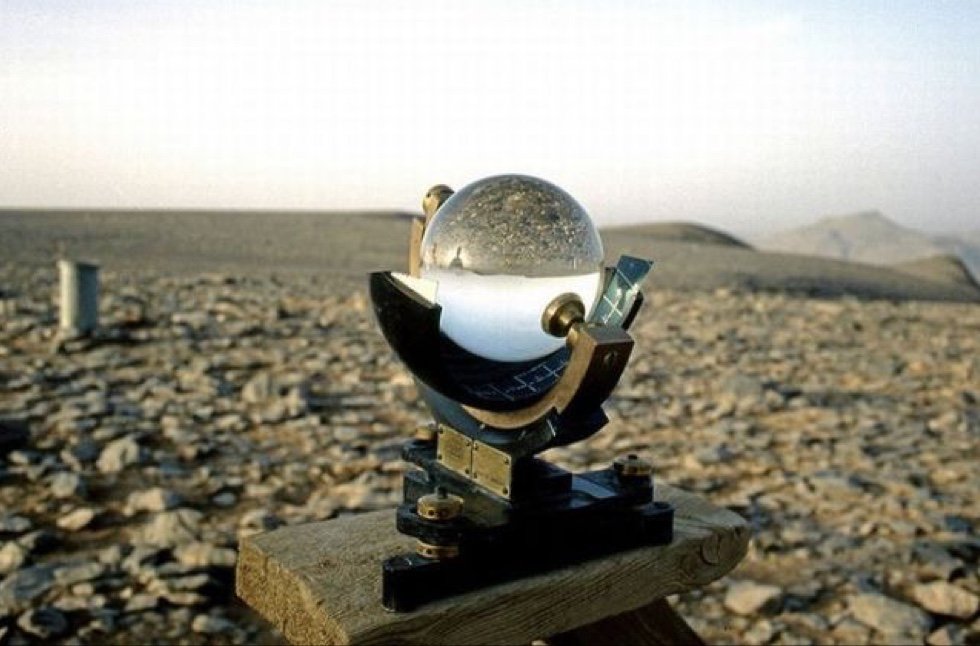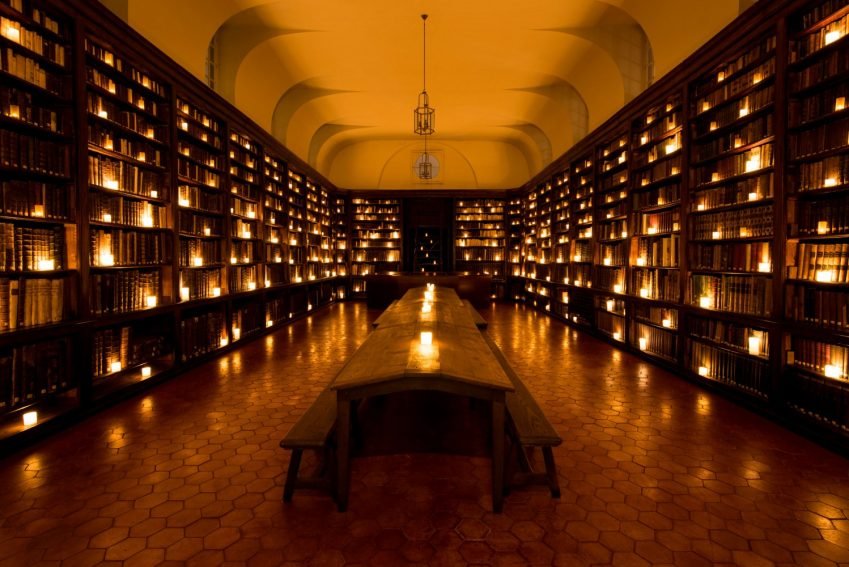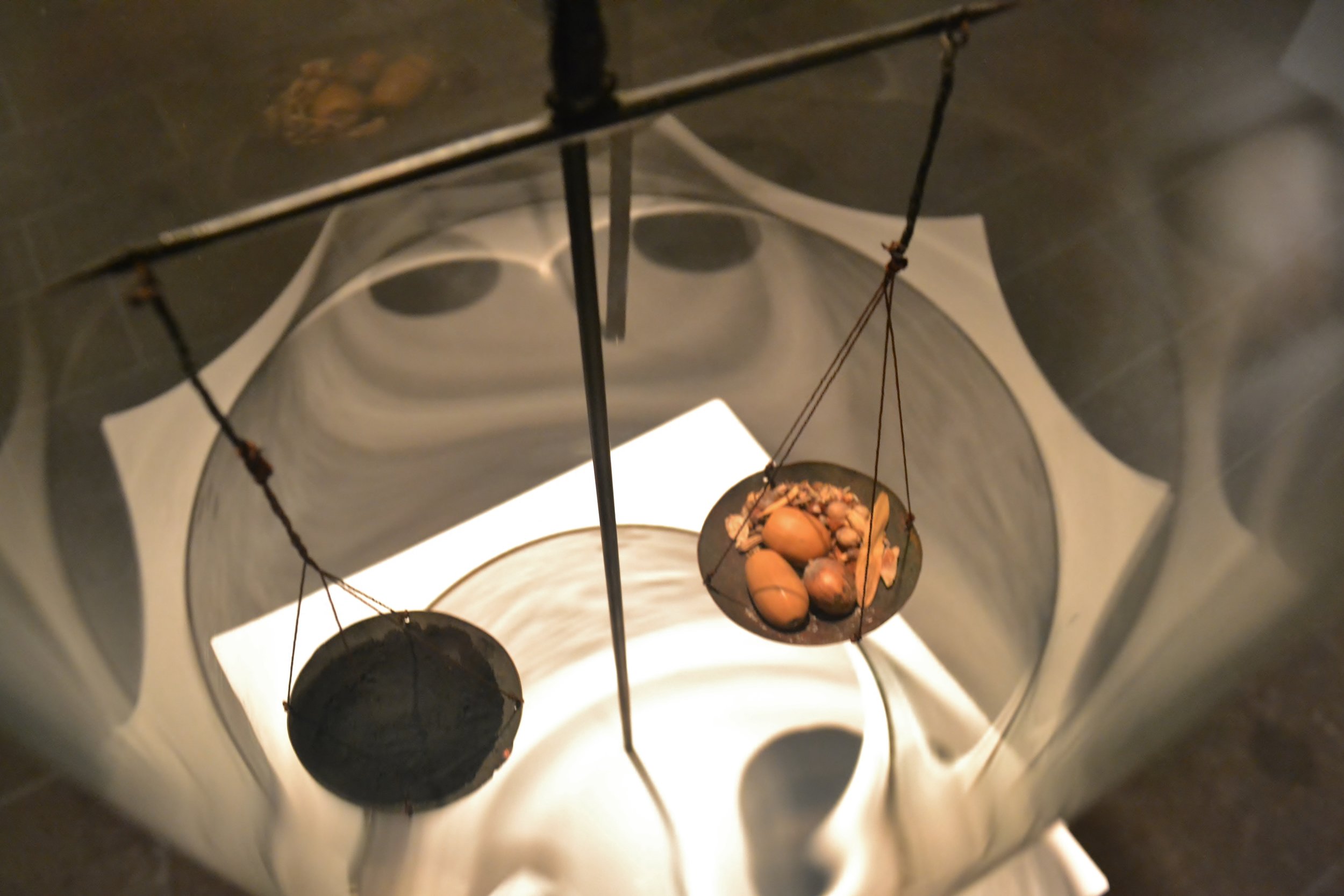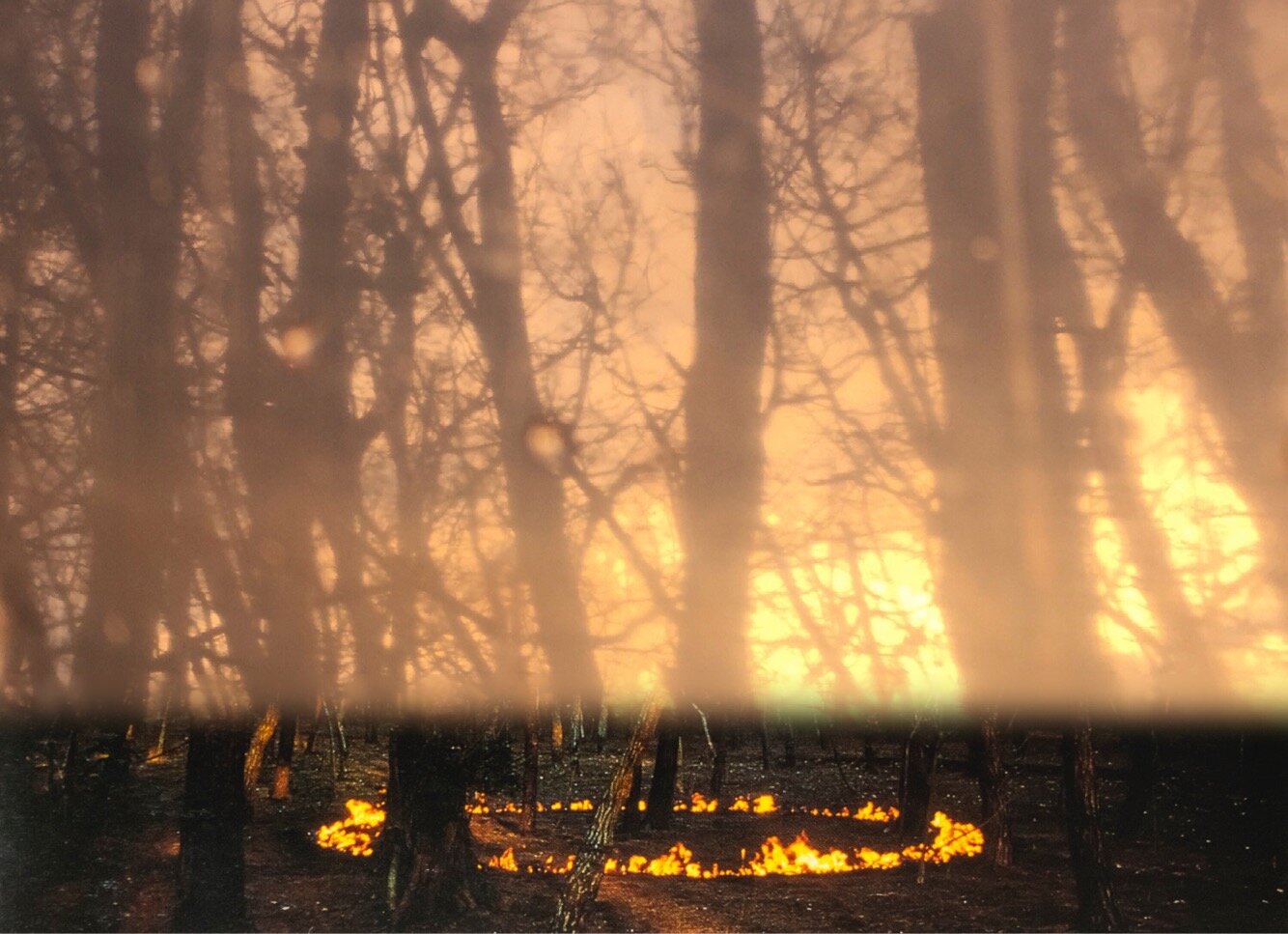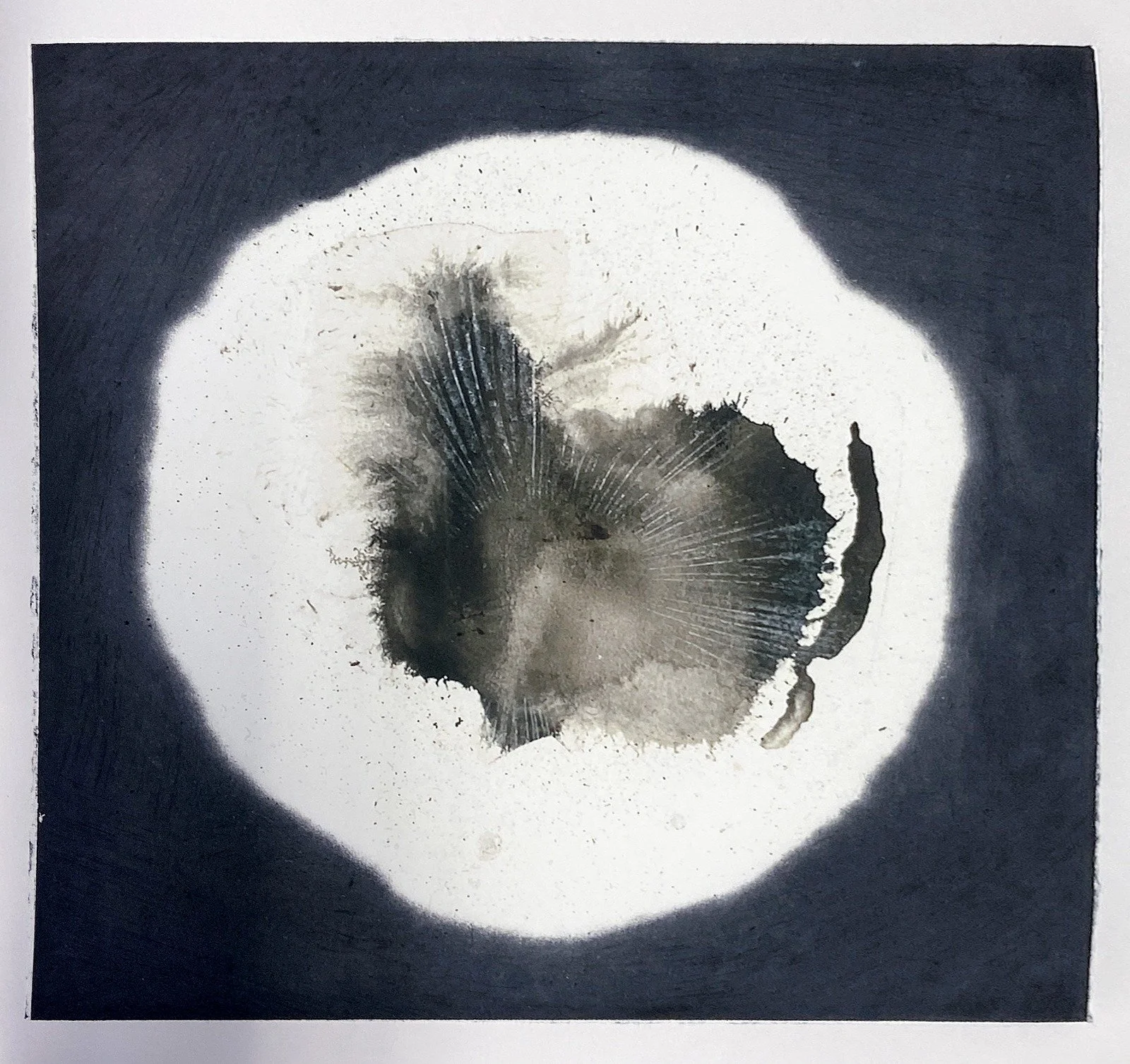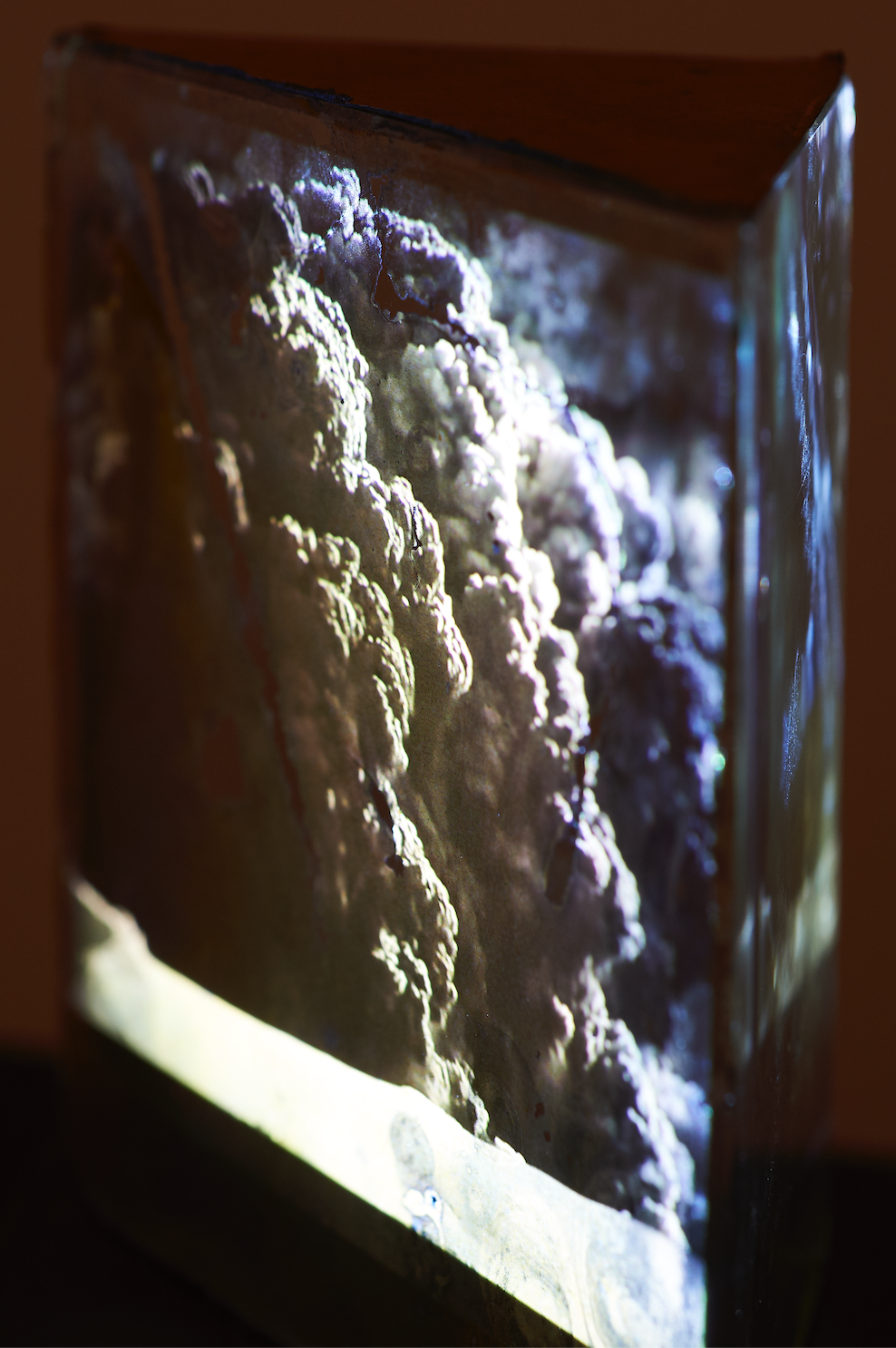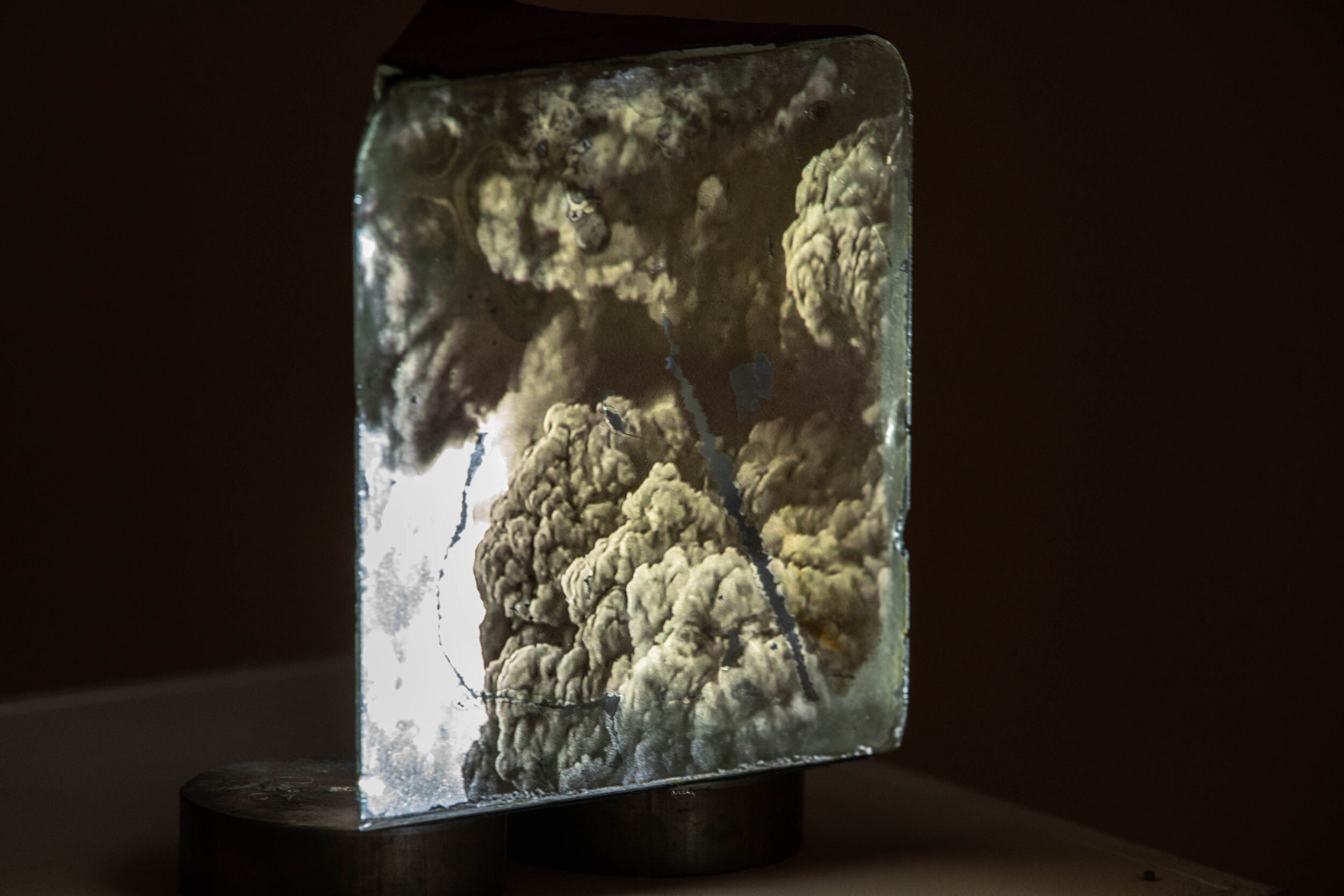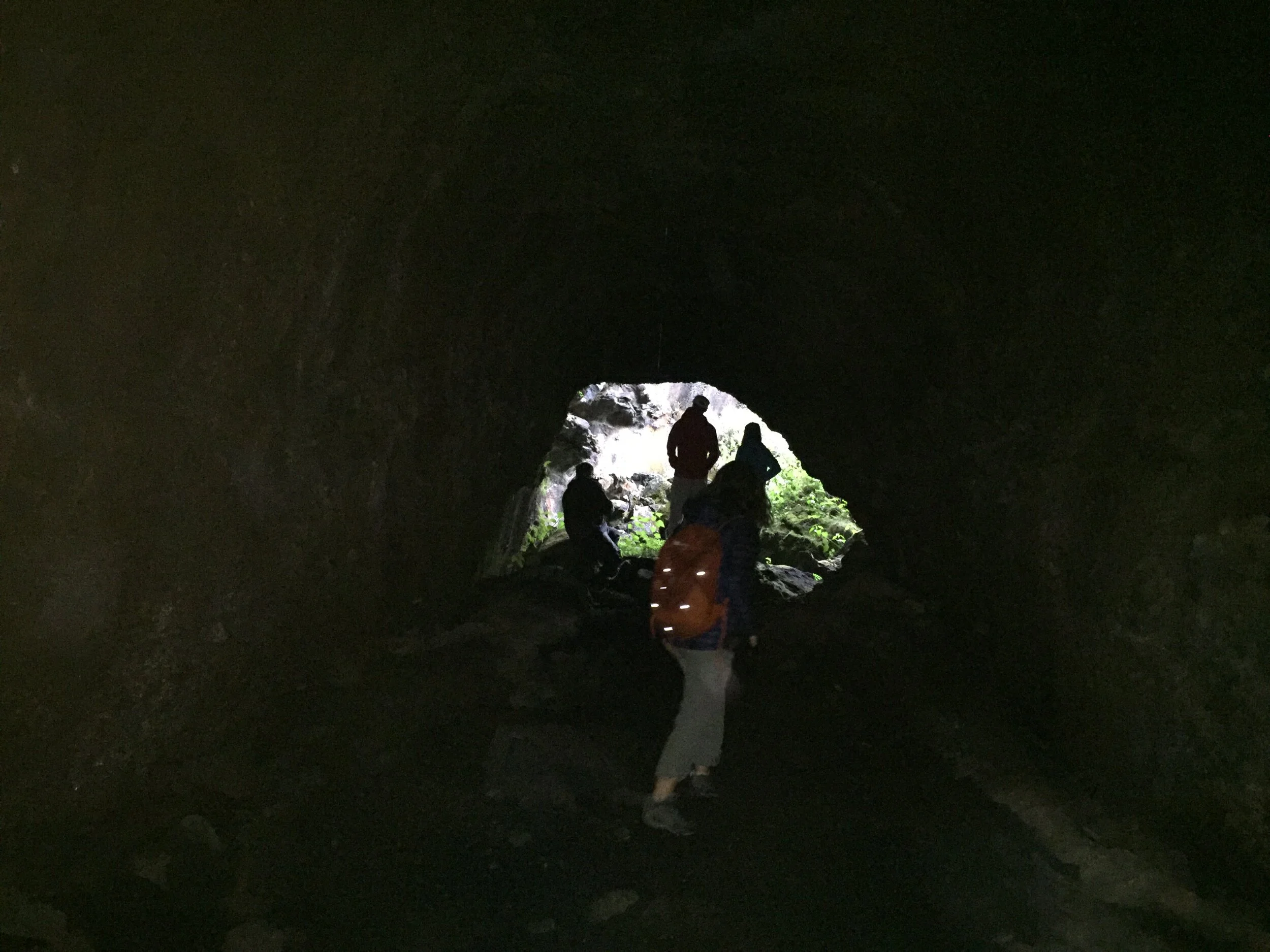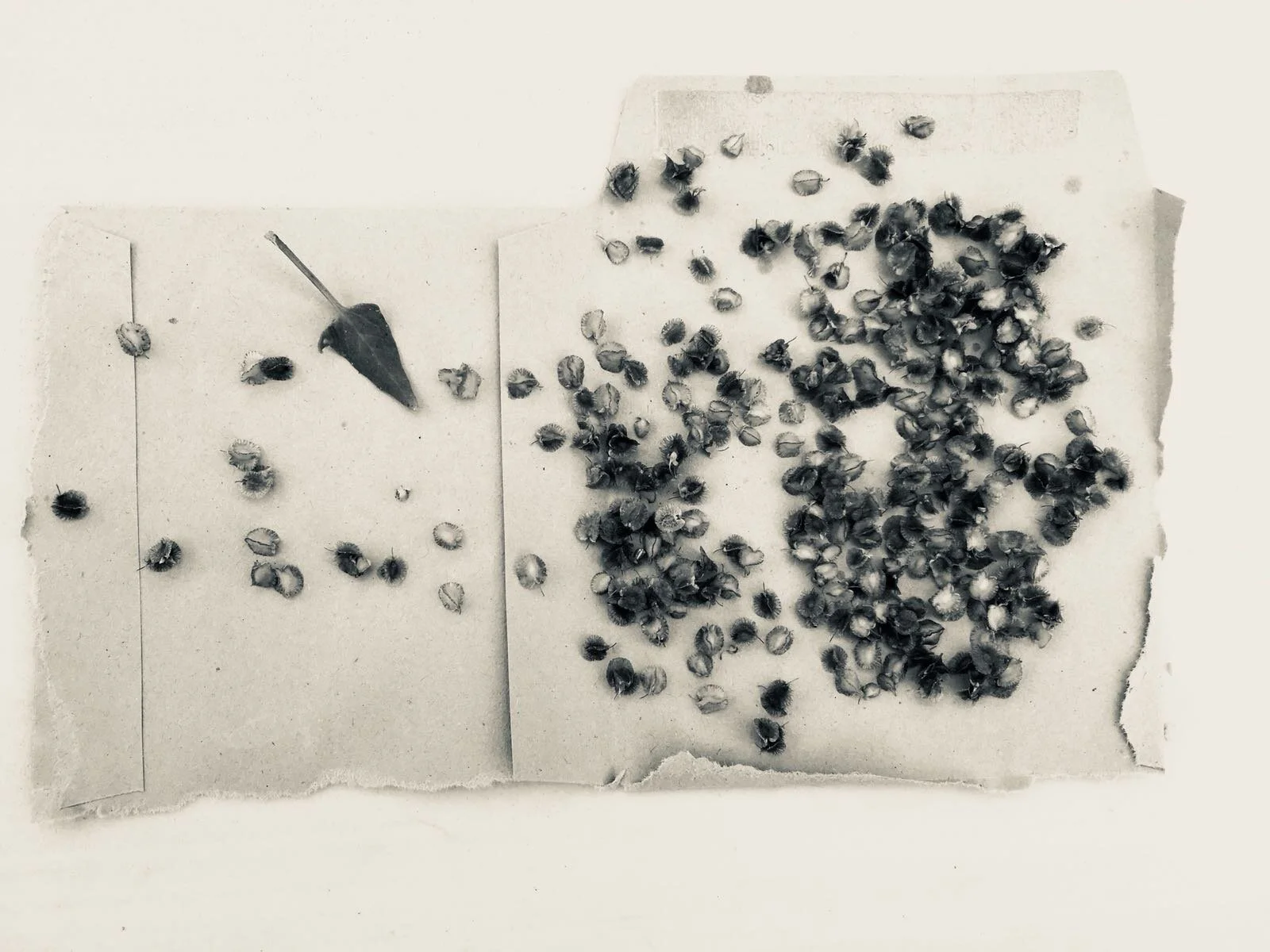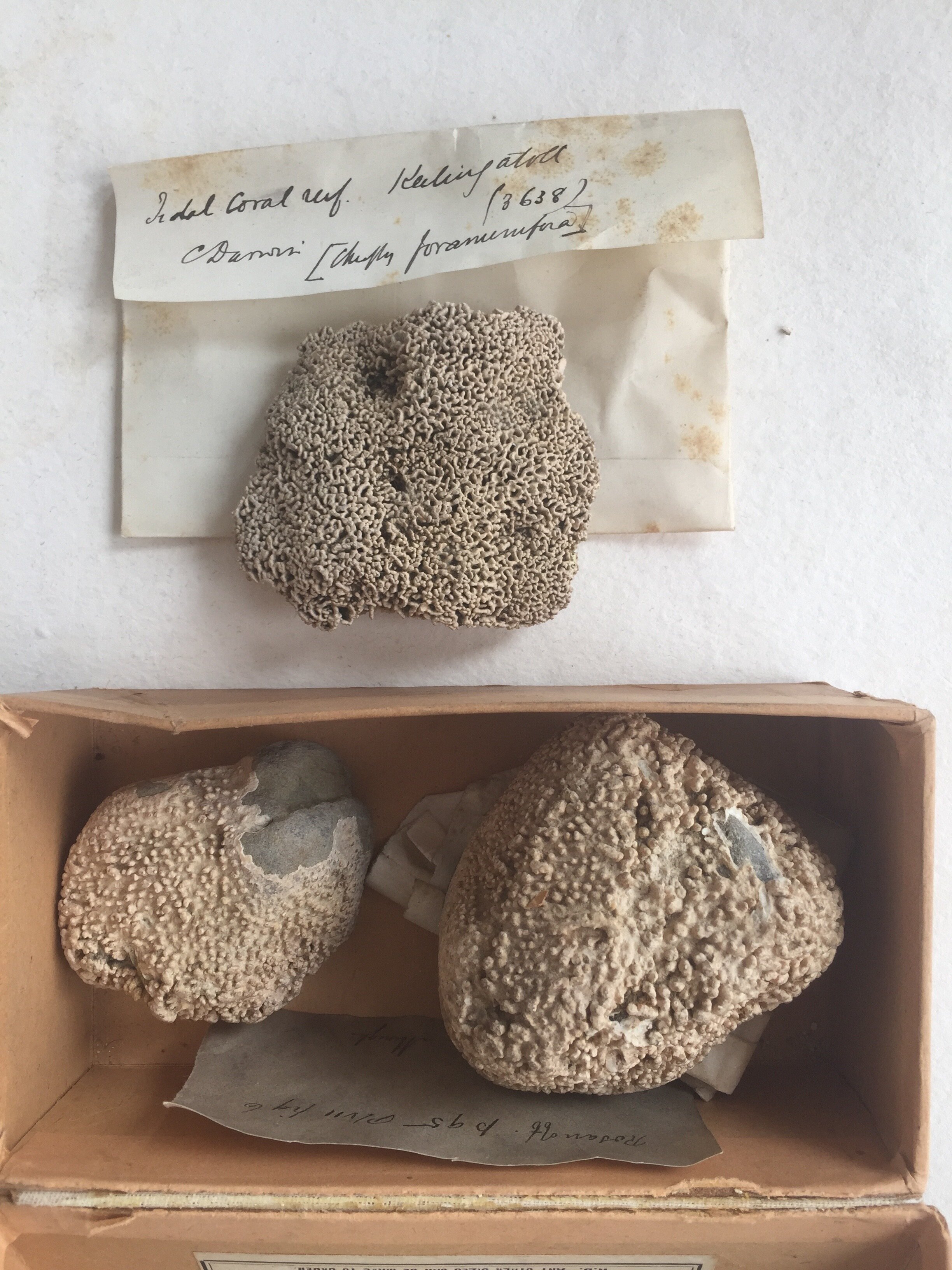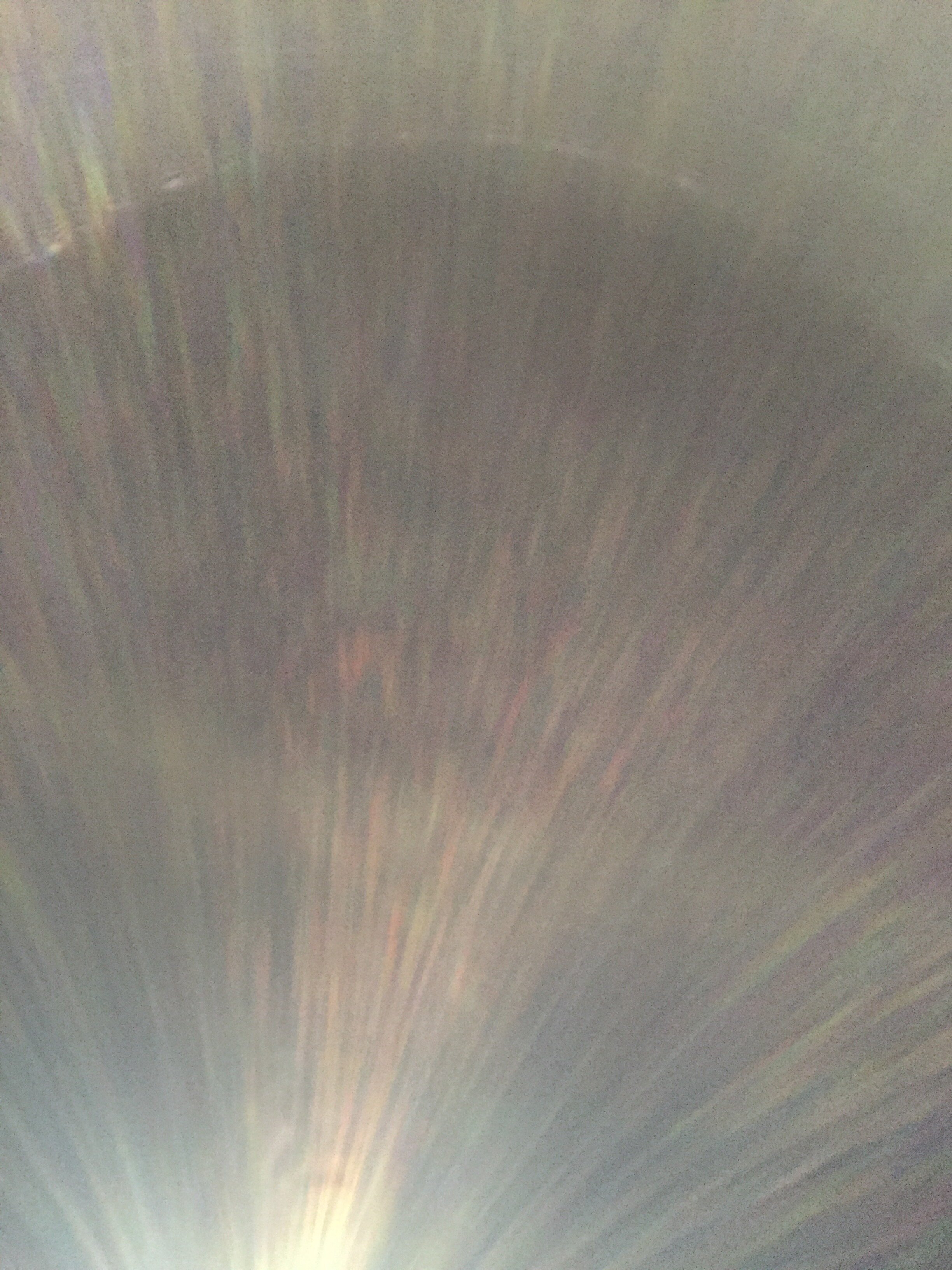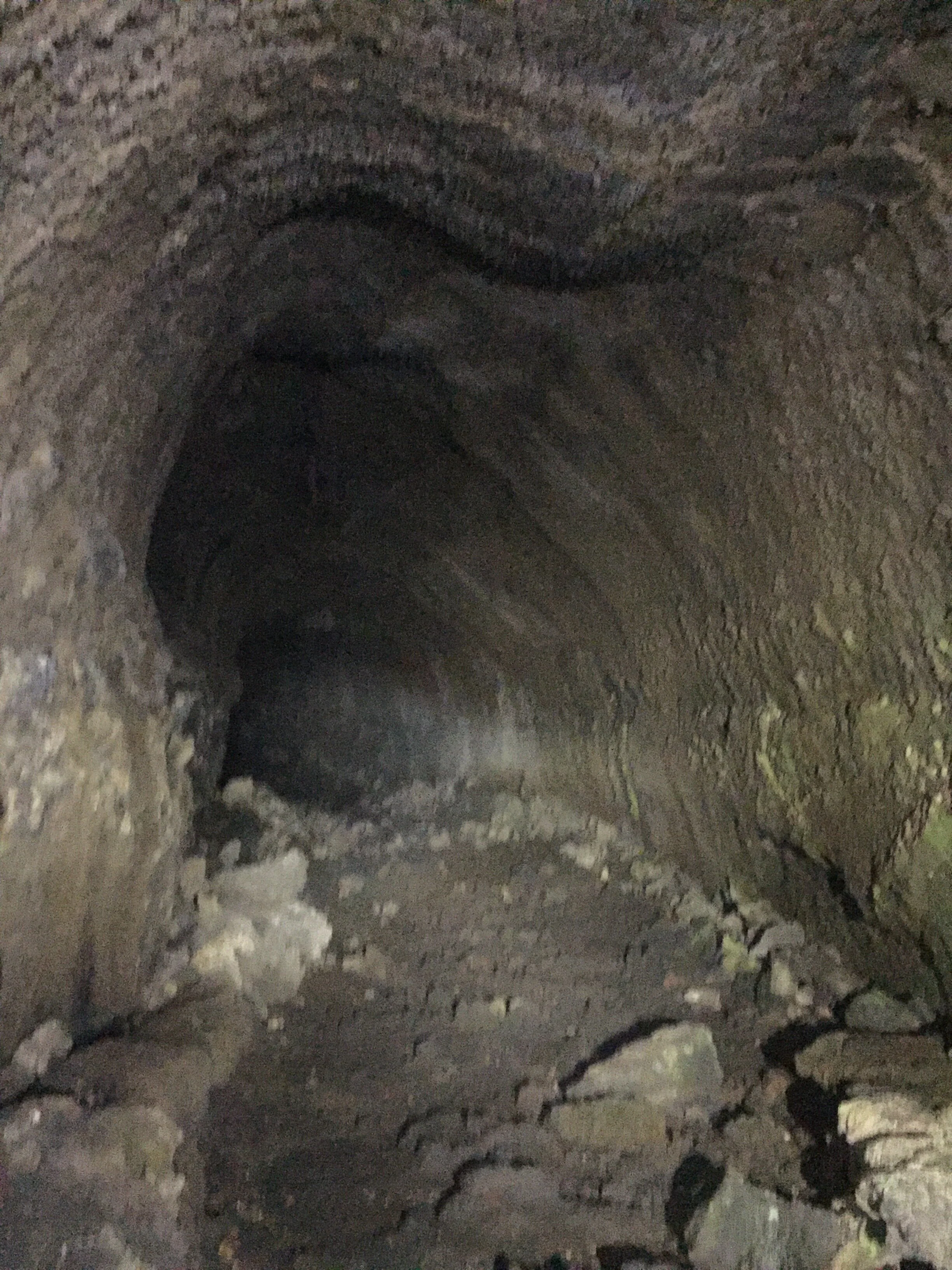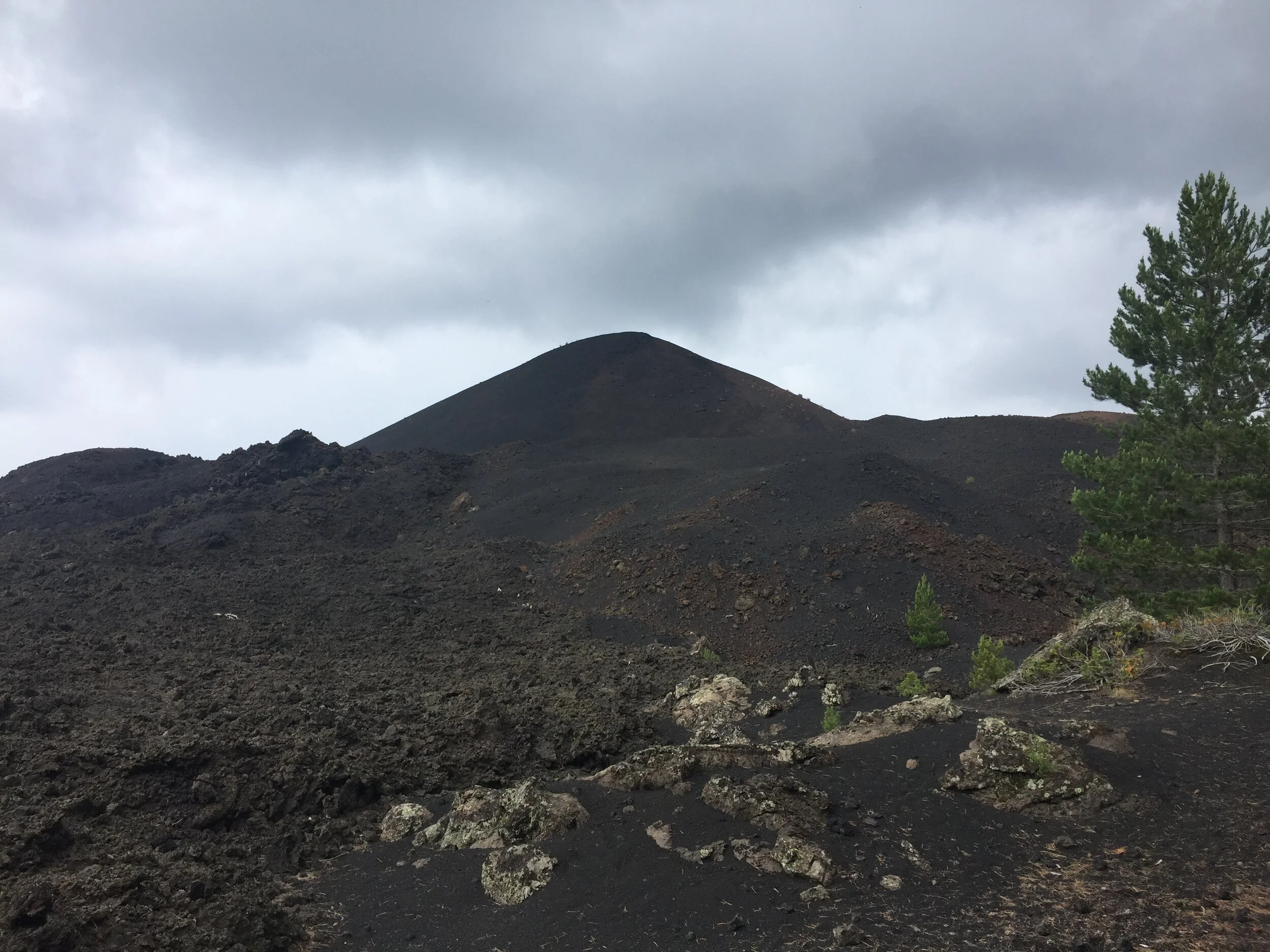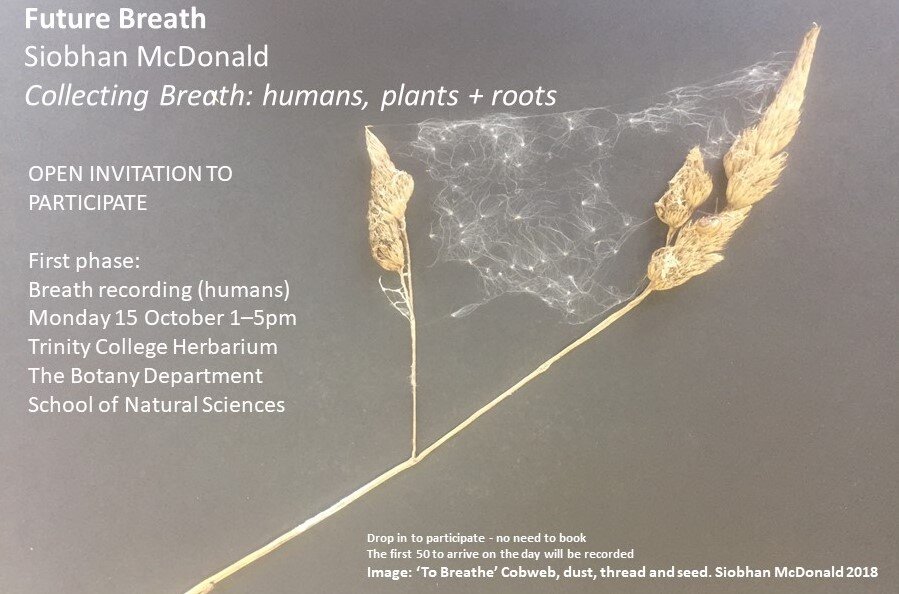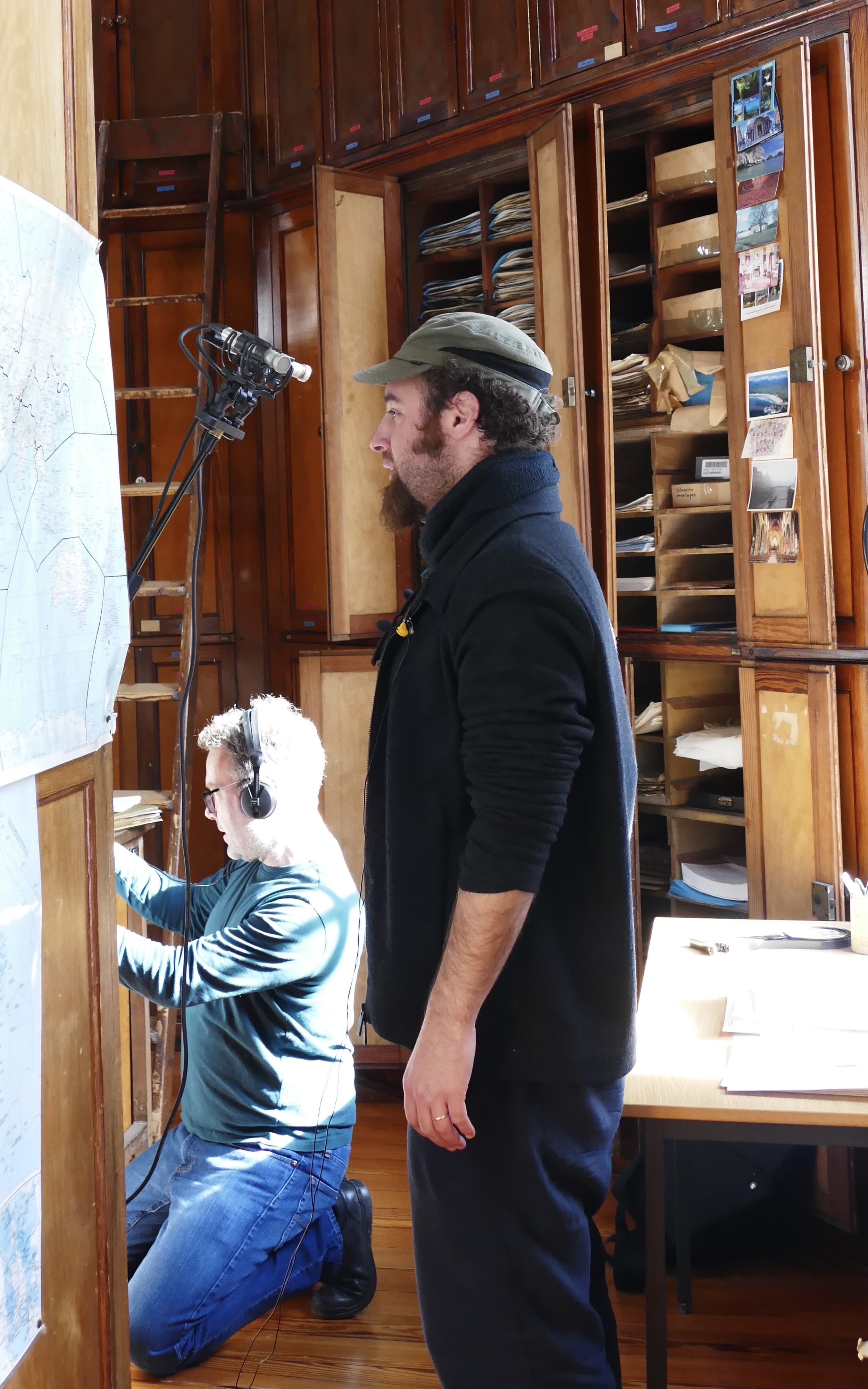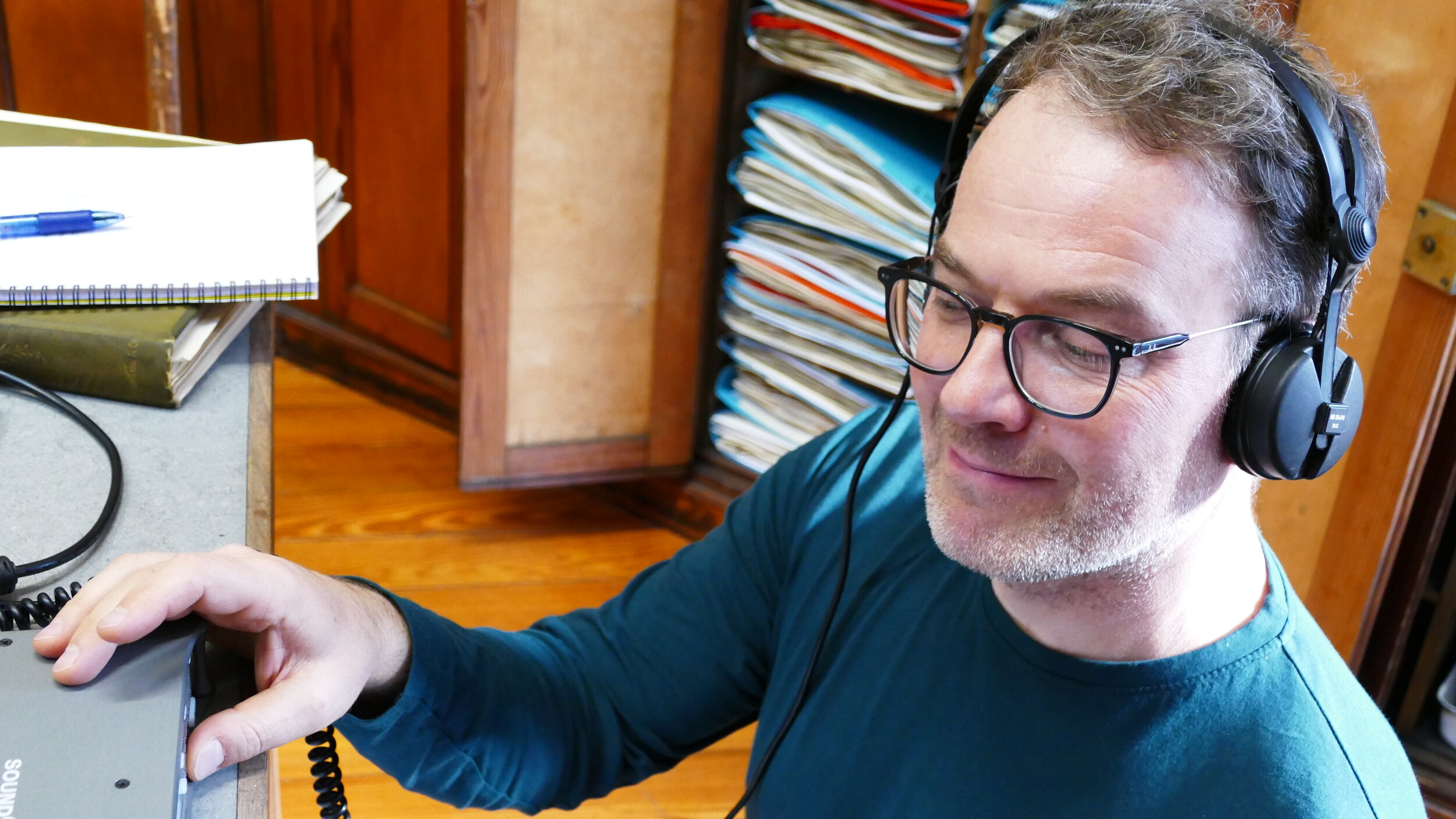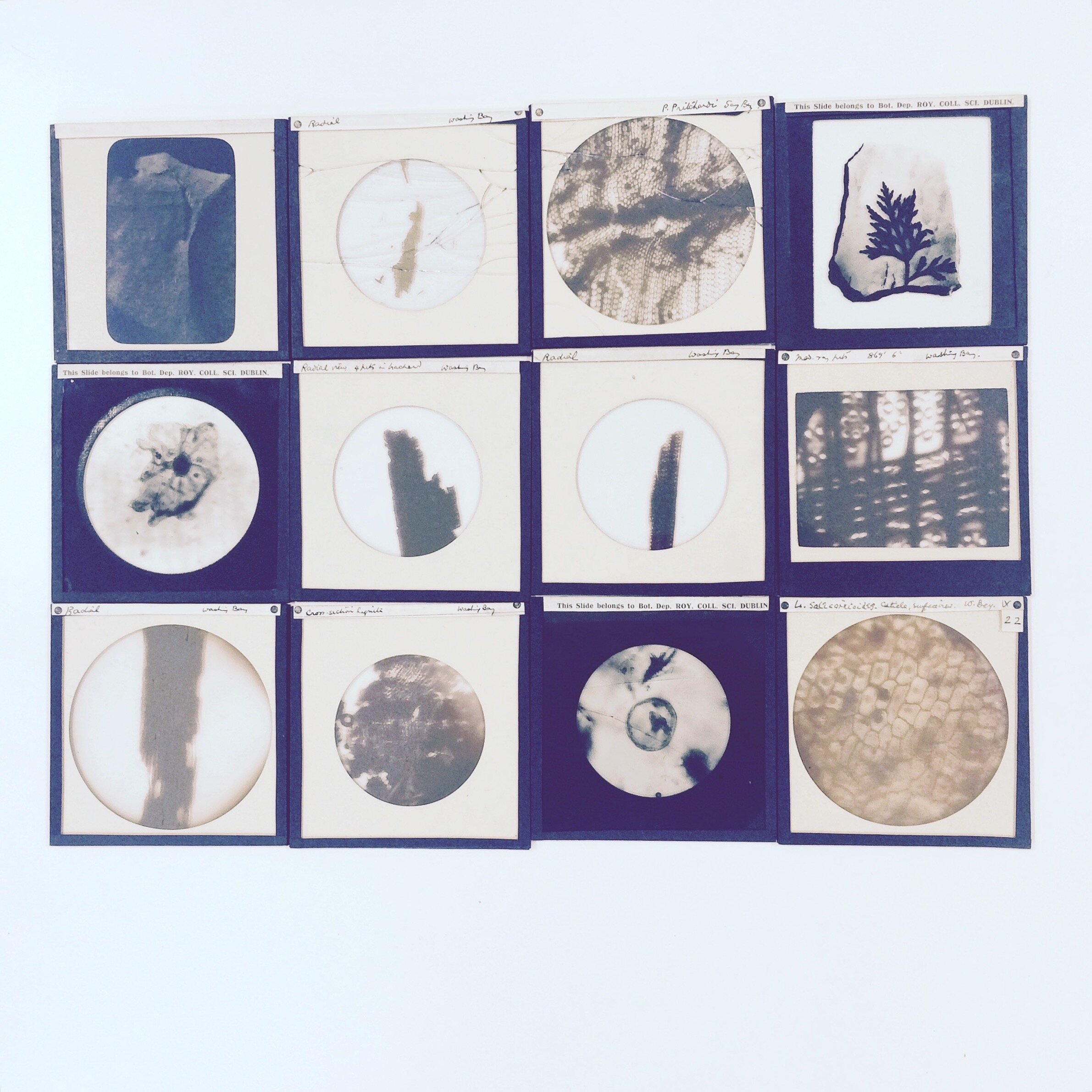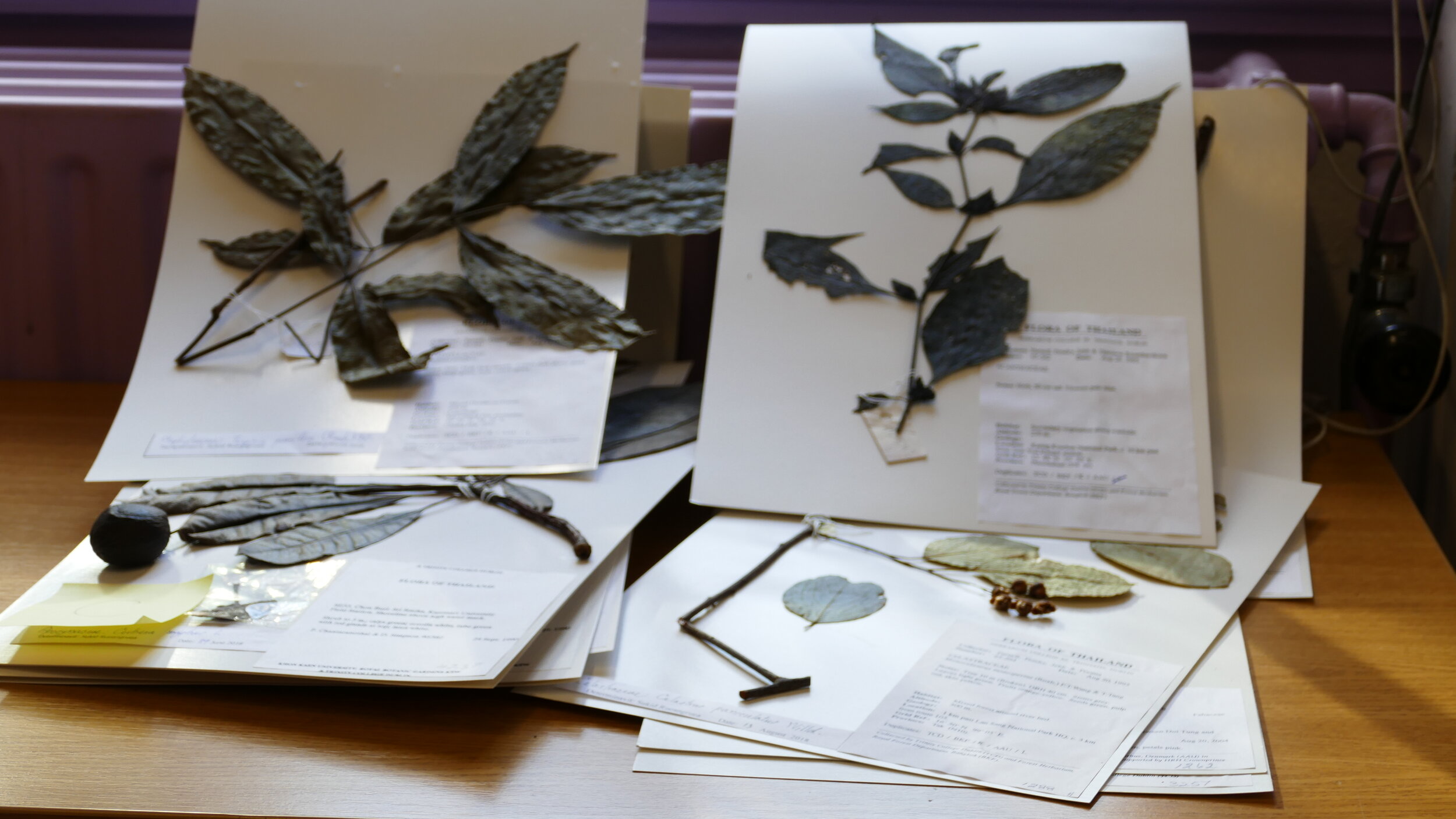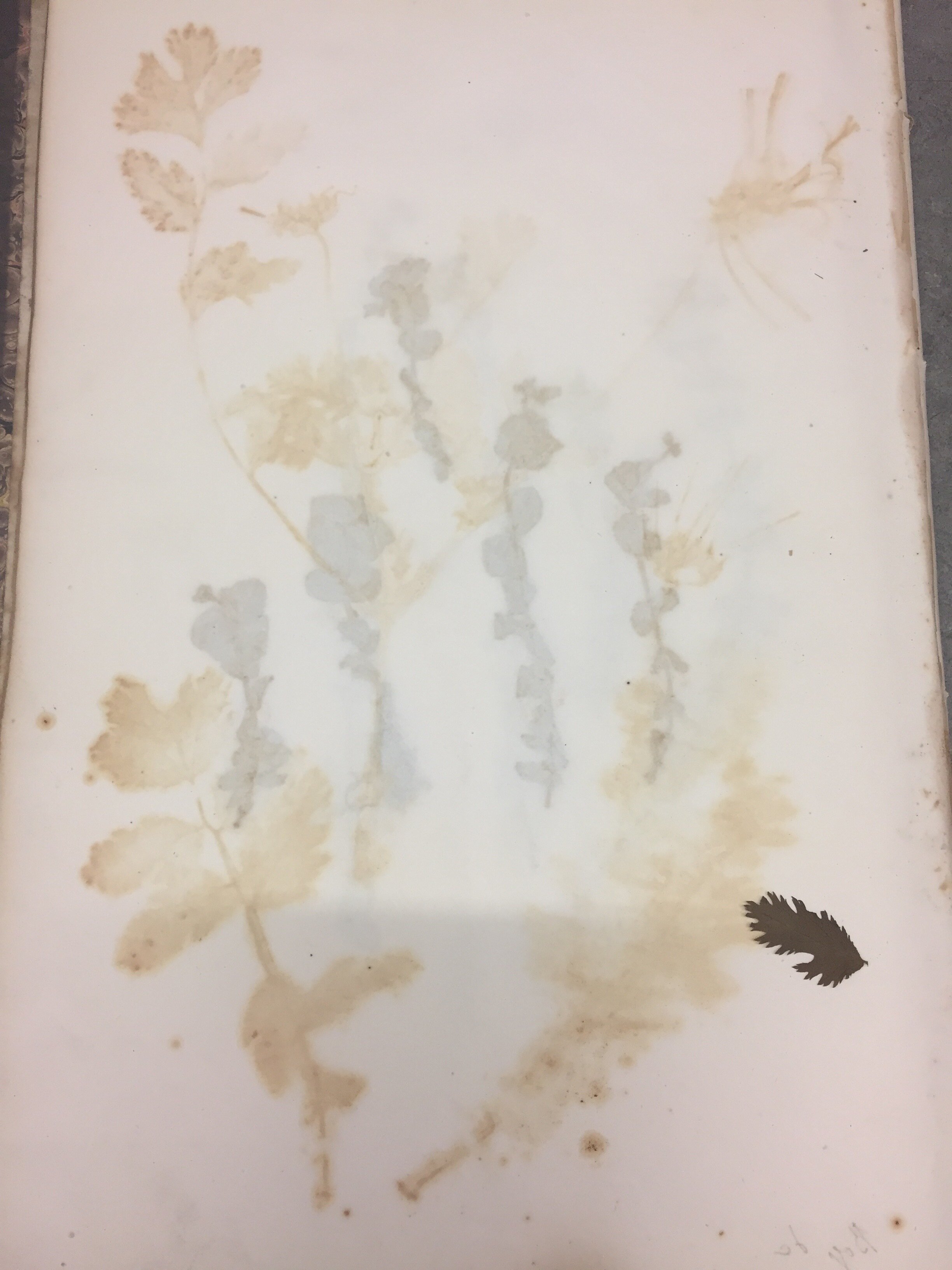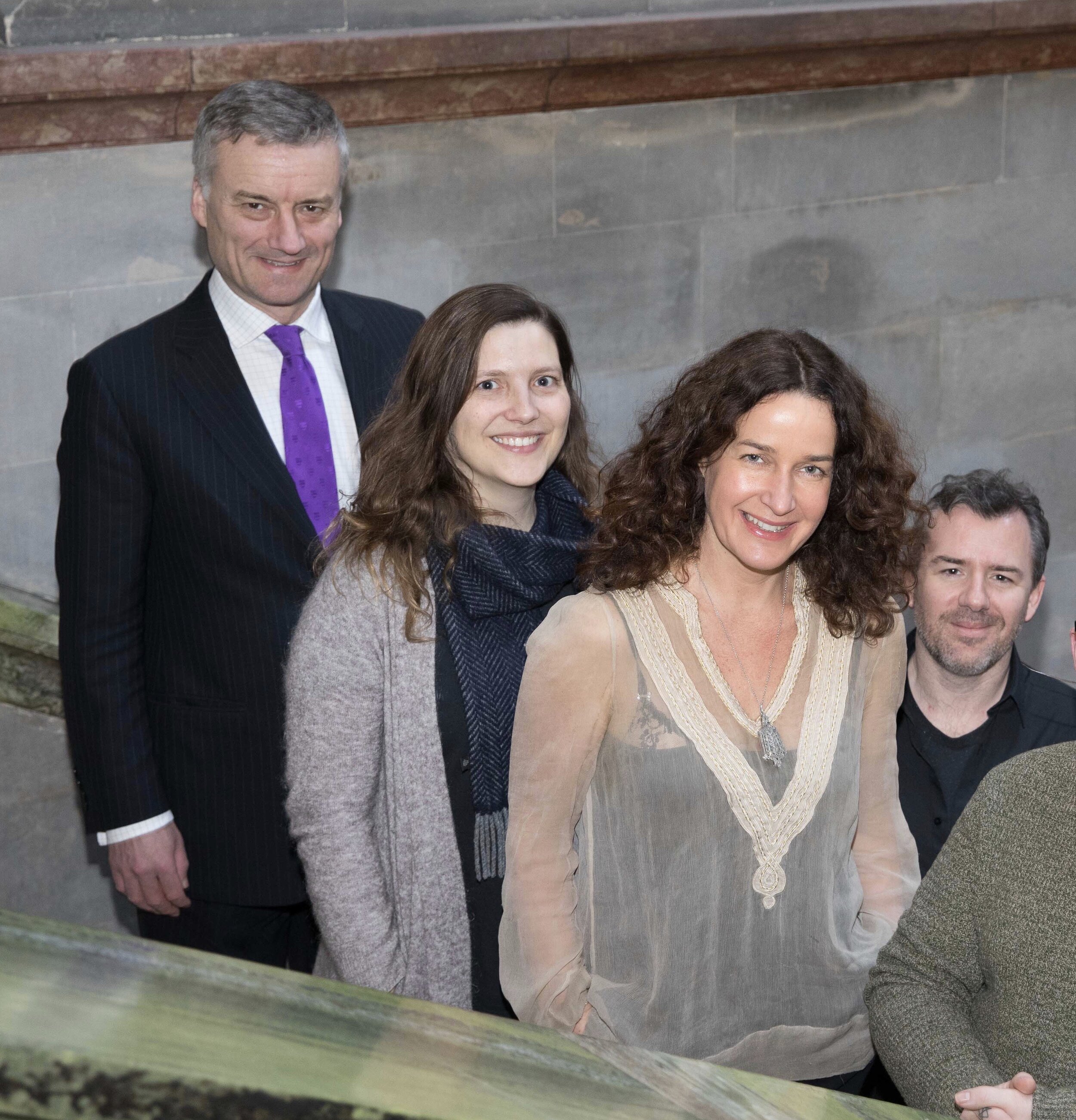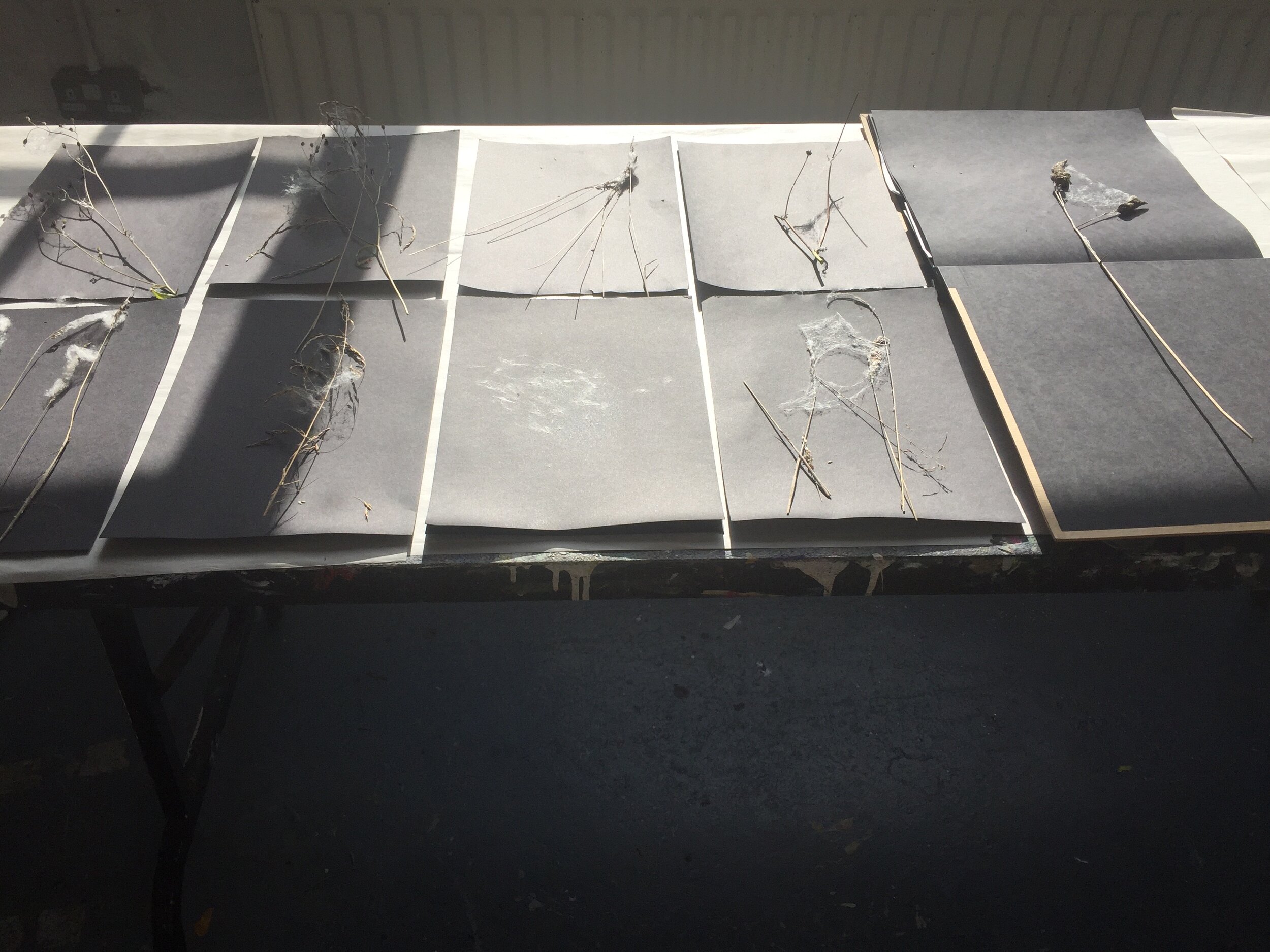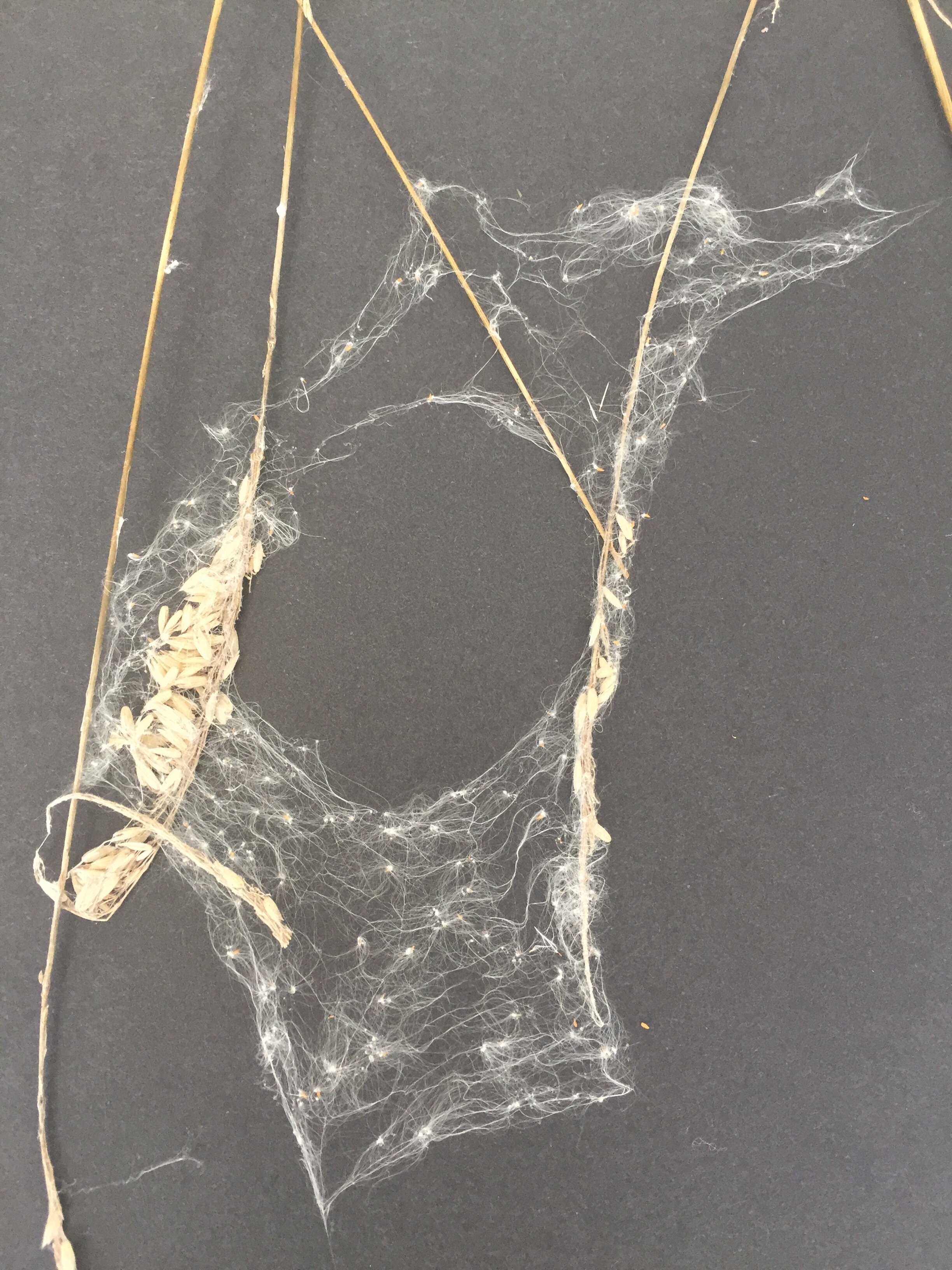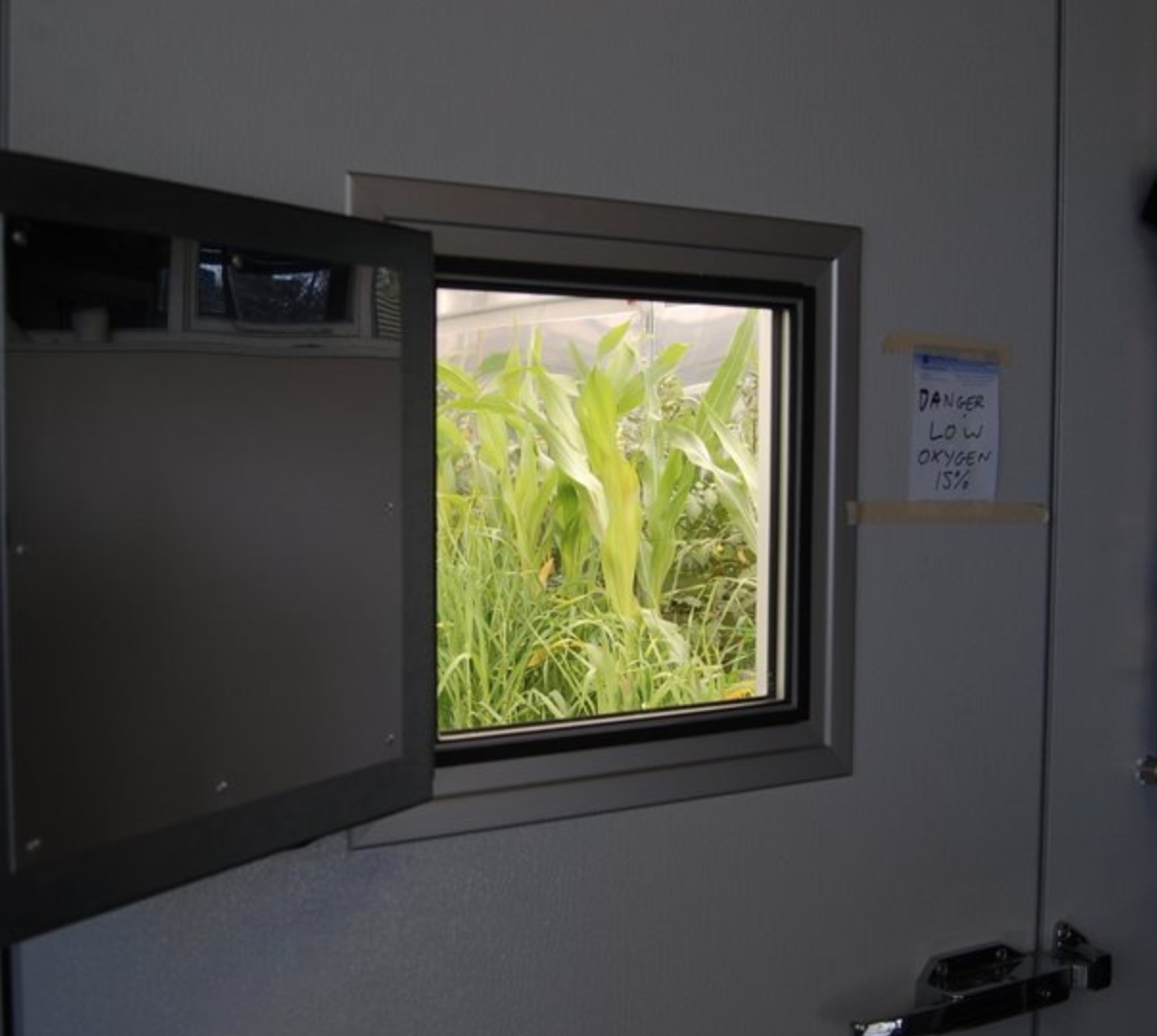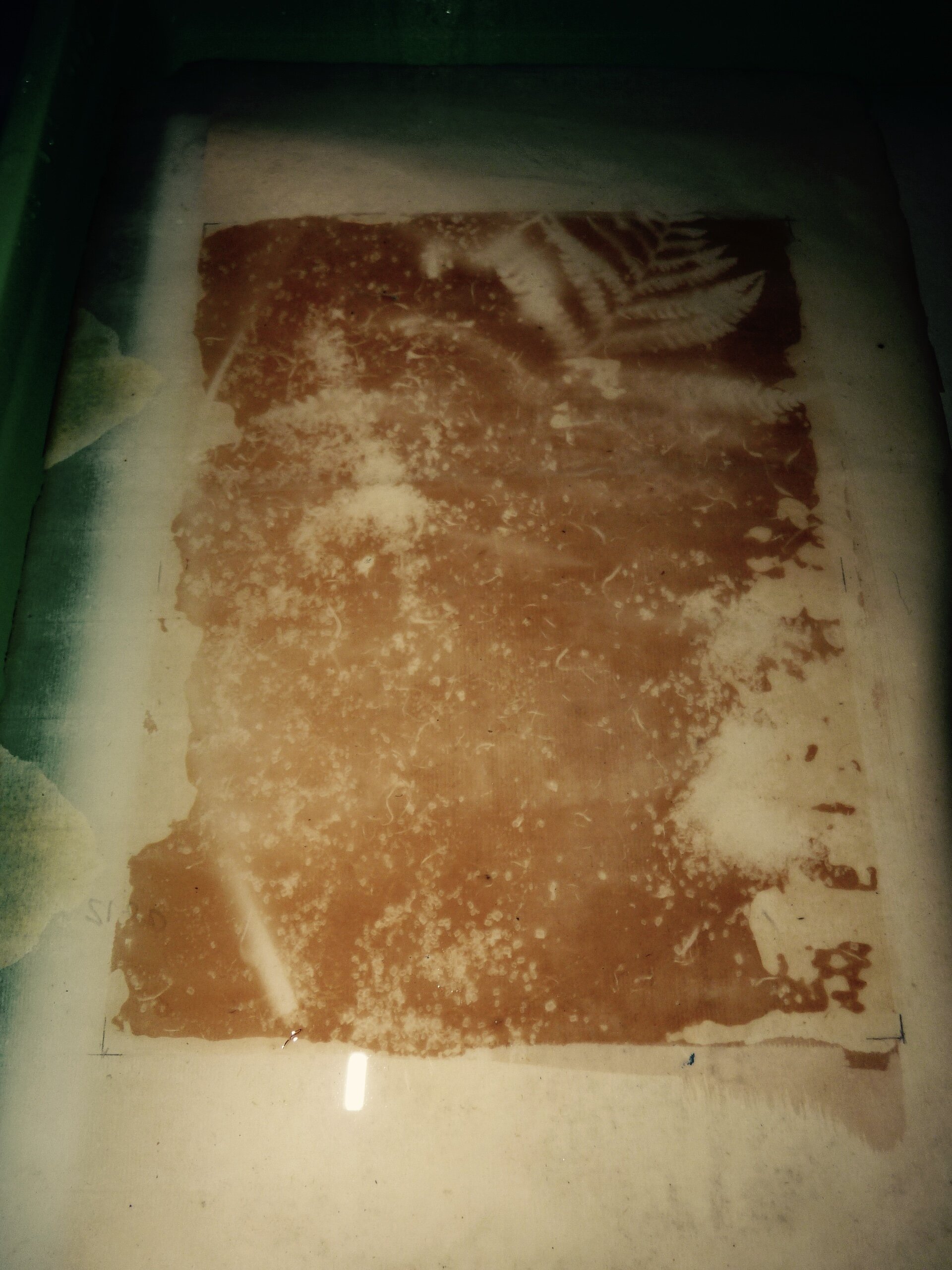Crystalline
Exhibition Series and Artwork
Crystalline: A project exploring the European Space Agency's (ESA) Solar Orbiter Mission. This installation brings the elements of contemporary engineering together with prehistory in the use of carbon and charred bone.
Crystalline is a project that addresses the demise of glaciers by merging contemporary engineering with elements of prehistory. Through collaborations with the European Space Agency (ESA) and NASA, Siobhán McDonald utilizes solar technologies in a series of artworks to depict the Sun's dynamics, capturing both its explosive power and serene beauty. A crucial element of this work is the use of NASA STIX X-ray technology. By adapting special NASA solar lenses for the project, McDonald explores realms and perceptions of reality, evoking the depths of the past.
The Guardian - Review 2017
Weaving themes of voyaging and perilous expeditions, the artwork commemorates the launch of the European Space Agency's (ESA) Solar Orbiter Mission in 2020. Bridging history, the exhibition connects the journey of the Solar Orbiter (2022) with the Franklin expedition (1845).
Utilizing contemporary engineering technologies and materials from ancient caves to explore time.
On 10 February 2020, Solar Orbiter—a joint European Space Agency (ESA) and NASA mission—was launched to journey to an unexplored part of our Sun. Since 2017 McDonald has collaborated with material scientists at ESA in the creation of a series of works to mark the Solar Orbiter launch and to explore the Sun's finest unseen moments, exploring its past, present and future. The Times - Review
SOLAR GAZE, A painting series, created using pigment made from charred bone of over 1000 species. Solar black; drawing on Japanese paper.
Composed of foam substrates and individually painted with Solar White, the Solar Orbiter pigment, McDonald cured the surfaces of each sculpture at high temperatures to create a motif of cracked and disjointed cartographies. They exude an air of disrupted beauty and reference the typography created over centuries by the moving glaciers as they melt.
‘Crystalline detail’
ARTIST SIOBHÁN MCDONALD WITH ESA SOLAR ORBITER PROJECT SCIENTIST, DANIEL MÜLLER, AT ESTEC
Through her work with the European Space Agency (ESA), McDonald explores the workings of the Sun with Daniel Müller and Joe Zender, addressing our star’s explosive power and serene beauty. In a series of interventions McDonald experiments with the scale and physical nature of the Solar Orbiter spacecraft down to its component parts; ranging from the hard metal structures to an exterior sheath that is used to protect against the heat of the Sun. This exterior sheath is an industrial material Solar White which bonds to the titanium heat shield of ESA’s Solar Orbiter and mirrors the crushed animal bone that Stone Age people used to make cave paintings. Inspired by this clear line between Solar Orbiter and prehistory, McDonald collaborated with the material scientists at Enbio in creating Crystalline.
Crystalline: Installation shot: Centre Culturel Irlandais, March 2018
‘At the Edge of Visibility’ 2016. 4 minute film by Siobhan McDonald. Shot in the Arctic Circle in 2015. Edited by Christopher Ash. Sound composition by Irene Buckley containing sounds collected in the Arctic by Siobhan, sounds of dying glaciers recorded by Professor Chris Bean and sounds recorded in space by ESA.
At the Edge of Visibility (2016) 4 minute, Premiered at Deutsches Hygiene-Museum ‘Shine on me’ curated by Katherine Nichols.
By 1823 the North American Arctic was still the last undiscovered ecosystem on the planet. It was a landscape so cold that it fractured everything it penetrated, including the stones. It was uncharted, unclaimed territory and Europeans had perished in it miserably. In 2015 the artist embarked on an expedition to explore this beautiful and vital Arctic ice which holds a memory that extends for millions of years into the past. At the Edge of Visibility explores the slow workings of geological processes found deep in permafrost, meditating on the sentience of ice.
The Guardian - Review
While in the Arctic I had taken along a heliograph, a device that was historically used to record the Sun. The heliograph, attached to the binnacle of the expedition ship, creates a response to the melting glaciers by recording a score of the Sun’s track at the summer solstice. Recorded messages and pulses registered as the Sun moved through the sky on 21 June to produce a series of notations for the soundtrack. The burn holes created are photographic in the strictest sense, as each mark is a small black Sun, and each dot is a repeat pattern of the Sun’s image scaled down many million times on its journey to the Earth.
“Beamed into space’ heliograph ‘score’ of the Sun’s track for the melting glaciers. The piece also contains whistlers collected at European Space Research and Technology Centre at ESA.
At the Edge of Visibility (2016)soundtrack, field recordings in space
“The Arctic taught me that sound waves are only a tiny aspect of the limitless vibrations that are untapped in the world. I also made infrasound (low-frequency) recordings with seismology equipment. I worked with composer Irene Buckley to develop a heliograph ‘score’ of the Sun’s track for the melting glaciers. The piece also contains whistlers collected at European Space Research and Technology Centre (ESTEC) at ESA. “McDonald works across a wide range of data, using every tool in her scientific and artistic repertory to inform and persuade us that the pace of deep time and geological change may still have lessons for us. McDonald asks us, instead, to look at the effects of imbalance, to listen to the drips of the dying glaciers, to witness the impacts of global warming in Crystalline…” ‘Born of a Singularity’,[1] Art and our position in the ecosystem. Catherine Marshall, February 2018
The week the sun touched the earth’ (2022)
Oil painting, film and easel
THE WEEK THE SUN TOUCHED THE EARTH by artist Siobhán McDonald, at the Irish Cultural Centre in Paris, pay tribute to the strangeness of our universe, when the sun meets the earth, especially during magnetic storms. And also to the beauty of matter and light, explored by the Solar Orbiter satellite. https://www.centreculturelirlandais.com/en/whats-on/exhibitions-events/siobh%C3%A1n-mcdonald-2
The exhibition weaves together themes of solar storms though the unifying perspective of deep time. McDonald use’s Ireland’s rich documentary and scientific heritage through the study of the corpus of Irish medieval chronicles. These represent annual chronicling of major events, originally recorded in major monastic foundations across Ireland, from the sixth century.
THE WEEK THE SUN TOUCHED THE EARTH premiered at The Centre Culturel Irlandais in 2022. Presented in the Old Library, the project depicts ancient and future solar storms in Ireland by bringing together echoes from different fields – quotations, mythology and language from the historic chronicles known as The Irish Annals, as well as contemporary dance and empirical cosmic data.
Through a series of enquiries, McDonald explores the differing scales of impact the Sun’s presence has on the Earth. The idea came about after studying solar storms recorded in the rich corpus of Irish medieval chronicles of early medieval Ireland in tandem with NASA images of the sun made accessible via digital archives. The cultural and linguistic aspect of the project is informed by the cultural history, quotes, mythologies and languages from the Irish Annals.
https://www.sciencesetavenir.fr/decouvrir/agenda/la-semaine-ou-le-soleil-a-rencontre-la-terre_162941
This 5-min film projection uses special NASA solar lenses adapted for this project to explore realms and perceptions of reality to conjure up a deep past. It also aims to capture the act of looking at solar storms to evoke the momentous cycles of solar activity whose magnetic fields have a direct impact on our weather.
“Like a passage into the unknown” ‘Delicately placed on an easel, in the venerable library of the Irish cultural center in Paris, sits a brilliant plaque which can hypnotize you, like the Moon slowly obscuring the daylight, for a good five minutes (1). Cosmic shapes emanating from a video projector slide across its surface. No “classic” scientific image but a ballet of diaphanous celestial crescents, like an escape to the depths of the universe. And if the eye is captured by the changing colors, from red to blue, it will also glimpse yellow plumes, traces of solar magnetic storms which shake our terrestrial and satellite communications systems, and can even destroy them !’
THE WEEK THE SUN TOUCHED THE EARTH
The Guardian - Review 2017
European Space Agency - Review
The Guardian - Review
The Times - Review
SCIENCE Magazine: Deep exposures: Repurposing scientific materials into works of art, an artist confronts the Anthropocene, By Deborah Dixon
Week the Sun Touched the Earth
Exhibition Centre Culturel Irlandais 15th-29th April 2022
Study for a volcano’ (2020) Eyjafjallajökull 2010 eruption film through glass prism, 2:20 mins a glass prism embellished with volcanic ash, air particles and 24 karat gold. Filmmaker, Christopher Ash.
The Centre Culturel Irlandais is delighted to present this exhibition of paintings on vellum, lithographs, film projections and objects by artist Siobhán McDonald
Siobhán is fascinated by natural phenomena such as the solar storm Aurora Borealis, and how to give artistic form to intangible scientific processes. Her work presented in the CCI’s Old Library explores ancient and future solar storms in Ireland by bringing together echoes from different fields – quotations, mythology and language from the historic chronicles known as The Irish Annals, as well as dance and empirical cosmic data.
A vital aspect of the creation of this work is the use of the NASA STIX X-ray technology. Through special NASA solar lenses adapted for the limits of this project, Siobhán McDonald explores realms and perceptions of reality, recalling or conjuring a deep past. The work aims to capture the phenomenological act of looking and seeing solar storms which occur on the North and South Poles as a double virtual reflection. The piece contains numerous drawings by Siobhan McDonald and archival material dating from nineteenth-century photography to explore how momentous cycles of solar activity originate inside the Sun.
'Star Seed Wishes' I – II (2022) Is a series of works detailing fragile imprints of seeds collected from the Hill of Tara. Painted with an ink of methane extracted from the Irish bogs to reproduce images of solar eclipses from a 1905 Sonnenfinsternis-Expedition.
For five years, Siobhán has been working with scientists at the European Space Agency (ESA) and Dublin Institute of Advanced Studies (DIAS) to artistically evoke some of the Sun's finest unseen moments, past, present and future. In addition to the artist studying NASA’s archival images of the Sun, a joint ESA and NASA mission launched in 2020 - Solar Orbiter – continually provides the artist with images of hitherto unexplored parts of our Sun.
A moment in time (2022) Glass prism sculpture capturing the photographic transcription of colors as revealed when light passes through an optical glass prism in the old library.
In parallel, Siobhan has searched for the occurrence of sun storms recorded in The Irish Annals that chronicled major events in Ireland up to the 17th century. Frequently linked to major Icelandic eruptions, with profound social impacts, examples of sunstorms include the “seizure of earthquake on the Shannon” in AD1178 (Annals of Boyle) and the “snow of the destruction” that fell in AD1179 (Annals of Ulster). By weaving together stunning imagery with elements of cultural history recorded in these Annals and the graceful movements of late dancer Emma O’Kane, the artist offers a window onto deep time and the awe we feel when faced with the mighty Universe.
‘The week the sun touched the earth’, 2022, HD film, 5 mins is a film work that employs multiple images captured of solar storm eruptions and will frame distant images of a dancer walking across the Sun. Oil painting, with 24 karat gold and film projection. Filmmaker Christopher Ash. In memory of the Magical Emma O’Kane
The film projection incorporates artifacts of Sun-recording instruments (DIAS) and uses special NASA solar lenses adapted for the project to explores realms and perceptions of reality and conjure up a deep past. It also aims to capture the act of looking at solar storms to imagine how ancient Irish people perceived the potency of the Sun as recorded in the Annals c. 600 AD.
‘The week the sun touched the earth’, 2022, HD film, 5 mins is a film work that employs multiple images captured of solar storm eruptions and will frame distant images of a dancer walking across the Sun.
In memory of the Magical Emma O’Kane
Oil painting, with 24 karat gold and film projection. Filmmaker Christopher Ash
A moment in time (2022) Glass prism sculpture capturing the photographic transcription of colours as revealed when light passes through an optical glass prism in the old library.
Hidden Monuments
Exhibition Limerick City Gallery of Art 2019
What remains, Floor installation: Birch, oak and willow, Dimensions variable. Siobhan McDonald LCGA Installation view Hidden Monuments, What remains.
Installation shot, Limerick City Art Gallery - Siobhan McDonald 2019
Hidden Monuments challenged traditional ideas of connections and transmissions between mankind past and present; opening us to the idea of communication through time using the Earth and it’s human-made monuments. Beginning with a series of artistic enquiries on the Black Pig's Dyke (a series of discontinuous man-made linear earthworks in southwest Ulster and northeast Connacht, Ireland), the project quickly progressed into a rumination on the Cairns, standing stones and Megalithic structures that foreshadow our own architectural histories. The project serendipitously coincided with the unprecedented rise in global temperatures in 2018 which magically drew henges in Ireland to the surface of the soil for exploration. This confluence of events informed the work, looking at these sites as portals of time, transmitting messages from an unknown past into our present.
Sound Inscription score
6 metre drawing on antique paper. Following a seam of geology and gold across Ireland. Linear earthworks circa 2000 BC
Installation shot, Limerick City Art Gallery - Siobhan McDonald 2019
Palisade
Pyrolysis (burnt in an environment without oxygen), Dimensions variable
Installation shot, Limerick City Art Gallery - Siobhan McDonald 2019
‘The idea of ritual plays a major part in her process. This new body of work includes film footage of ritual fires, performative pieces and temporary land art McDonald has made on and around the area of the Black Pig’s Dyke. The show will include paintings on 24-carat gold plated copper plates, which she also sometimes burns using a blow torch. They look abstract, distressed, a word she uses when talking about other images she has made. It’s a word that speaks to the fragility and the anxiety inherent in the work. Despite it all, she is optimistic. Her art is not deeply negative, although it is urgent, pensive, and full of thought-provoking beauty.’ wrote art critic Cristín Leach in her 2019 review of the show.
Siobhan McDonald, On-site interventions on The Black Pig’s Dyke on Winter Solstice 2018 and NewGrange during the drought in July 2018.
Leach further describes the materiality of the work as using “gold and copper because they are conductors: ‘I like their ability to reflect and to conduit, they are signalling to us.’ She uses calfskin, ‘because it’s a material used to record Irish history, our earliest weather records were recorded on calfskin.’ She uses charcoal because it seems to join the dots. She asked herself, ‘the first-ever marks made in the world, and the future – what’s the connection? Charcoal is the answer.’”
Borders of one kind or another have been part of the human story for thousands of years. Many of the Neolithic tombs and Bronze Age standing stones may have acted as territorial markers, with natural features also playing an important role.
Previously a complete absence of contemporary historical records relating to the linear earthworks, The Black Pigs Dyke, had hindered understanding of its origins and use. From 2017 onwards, McDonald worked alongside archaeologists on a series of breakthroughs made from a radiocarbon dating programme which uncovered the exact age and context of these site. Siobhan then began to explore the questions that remained unanswered: What was their purpose? What was it that motivated prehistoric societies to go to such enormous efforts to build these monumental structures? How precisely were they built?
The monuments date from a time in history, the years 100 - 200 AD, when Ireland was suffering from unprecedented changes in the weather and these archaeological remains, left in the landscape from Donegal to Co Armagh, point to a collective response and action; the activation of rituals while also communicating ideas of power and status. Whether these were intentionally built as ritual sites or not, the work explores this glimpse of how our ancestors dealt with their climate crisis and asks what we might learn from it to deal with ours.
Siobhan McDonald, Signals, onsite intervention on Black Pig's Dyke. Winter Solstice 2018.
Cosmic gas
Centre for Contemporary Art LAZNIA 2022
Cosmic Gas, Drawing on Japanese paper devised from poisonous invisible methane gas.
Centre for Contemporary Art LAZNIA 2022
Cosmic Gas (2021) is a drawing and lithography series that fuses materials devised from poisonous invisible methane gas and explores ideas of what manages to live in the ruins we have made. The project examines delicate ecologies and co-existence between the lungs of the earth, humans and plants as the permafrost melts and slowly releases toxic gases into our air.
Cosmic Gas, Image by Siobhān McDonald, Cosmic Gas, 2021. Plant fragments, arctic water, mycelium and ink on Japanese paper
The works have a living and dark presence made from the direct imprints of plant fragments collected from bog sites that used to be living organisms and have eventually became gaseous. The work is rooted in the medieval mythology of boglands as a cultural preserver offering an insight into ancient pagan times. The strange landscape of boglands with many rare geographical features and occurrences explains for the large mythology surrounding it. Tim Robinson, a celebrated writer and cartographer remarked of an Irish bog “Mind is being reabsorbed into matter; humanity’s imposition of languages, order, meaning, is being sucked down and choked off by nature.” Maybe it is this mysterious timelessness that placed the bogs as reminders that we are not mortal. That we are made of the same material.
Cosmic Gas, Drawing on Japanese paper devised from poisonous invisible methane gas.
Centre for Contemporary Art LAZNIA 2022
This project is realized by Siobhan McDonald. With thanks to the Joint Research Centre, Soil Action, JRC-ISPRA. Commissioned by GLUON with the support of the Dublin Institute for Advanced Studies and the Creative Europe programme of the European Union, within the framework of STUDIOTOPIA, JRC-ISPRA, Arts Council Ireland, The Model and Creative Ireland. ©️ Siobhan McDonald
Cosmic Gas, 2021. Plant fragments, arctic water, mycelium and ink on Japanese paper
Graphic Print Studio, 2022
Tipping Point
Exhibition Palais des Beaux-Arts
…
Tipping Point (2022) presents a hand-blown glass vessel containing a 12,000 year old ice core and 2,00 ml of air as a means to imagine the altered temperature, atmosphere and biosphere that will be present in an unsustainable future.
Methane lake (2022), is an evolving work made from air collected over the Yakutia lake in the Siberian Arctic. The toxic methane is the substance used for ink that reveals the hidden histories contained in polar ice. In combining ice and recordings from deep in the glaciers, the artist builds a bridge between our ancient ancestors and the history beneath our feet.
A World Without Ice (2022) is a soundpiece that centres on the realm of collective unease while simultaneously pointing to a place of hope. Acoustically reimagining the celestial ‘Harmony of the spheres’ for a human-altered planet, this composition gives sonic expression to the changing frequencies of nature and the broken rhythms of the Earth in the Anthropocene. The piece plays with a world rhythm in subtle ways to explore a Byzantine Manuscript that illustrates the physics of a pure vibrational frequency. The simple chord structures, based on fifths, creates changing sound surfaces generated with the aid of humming devices and site recordings from the dying glaciers and exposed boglands.
breathe
Connected by Air, film on Glass prism, 2 minutes, 20 seconds film. Eyjafjallajökull 2010 eruption. Glass prism, volcanic ash, air particles, 24 karat gold, solid silver, smoke, plinth + project. Film editor, Christopher Ash. Footage by Fredrik Holm
Installation shot, BOZAR, Brussels 2021
BREATHE weaves together narratives of studies in human breath, medicine and ancient plant remedies to explore the idea of coexistence in a world moved by invisible networks. Research was conducted in response to Wilhelm Pfeffer’s chronophotographic experiment involving the stages of plant growth. The project was supported by Deutsches Hygiene-Museum, Dresden, for the exhibition Of Plants and People. Sound composition: David Stalling: Stereo sound, duration 3’35” incorporating plant, tree and human breath recordings. Christopher Ash (film editor)
BREATHE is an exploration of air pollution and the influence of major European volcanoes—Etna, Stromboli, Vulcano, Campi Flegrei, and Vesuvius—examining the act of breathing through the lens of air.
BREATHE is an installation of works that provides an examination of breathing – why we breathe, how we breathe and what we breathe –exploring, the impact of pollution on the environment and breath as meditation. The works explore the importance of air and the co-existence between the lungs of the earth and humans. Using global seismic technology and ambient air monitoring, the project traces active eruptions to point to the cycle of the earth breathing within the carbon cycle of our ecosystems.
The first work entitled Connected by Air focuses on air and how we, as humans, can affect our surroundings. The installation is composed of a series of glass prisms embellished from the repeated application of thin, transparent layers of pigment made from volcanic ash to form an optical quality surface. The prisms appear identical, but when you look closely the film projections make the reflections on the surfaces distinct. The work premiered at Palais Des Beaus-Arts (Bozar) in 2021. The artwork takes as its subject the delicate ecologies and co-existence between the lungs of the earth, humans and plants. The project explores a selection of major European volcanoes and points to the cycle of the earth breathing within the carbon cycle of our ecosystems.
The artwork employs advanced seismic technology to illustrate the impact of volcanic eruptions on air quality, engaging visitors with the subtle light shifts that mimic the movement of underground volcanic signals.
The first inquiry is set on Eyjafjallajökull, the largest glacier and volcano in Europe. For over a decade, McDonald visited the highly eruptive part of Iceland to film the tension and perceived underground silence before an explosion. ‘When Eyjafjallajökull erupted, suddenly the wind currents became very present and particles of ash were disseminated through the air.’ Seeing this as a microcosm to represent the larger global ecosystem, McDonald explores what it means for us as we enter the next phase of human-induced climate change.
Together with scientists from the European Commission’s Joint Research Centre the project expanded into a wider inquiry of air and the role of major European volcanoes such as Etna, Stromboli, Vulcano, Campi Flegrei and Vesuvio to look at evolution and health through the prism of air.
Interventions and field trips to Catania, Sicily, Mount Etna’s pulsing, volatile terrain, inspire to unlock the potential of its chemical make-up. Namely, that the ash clouds above Mount Etna might enable us to counter the damage caused by our planet-warming carbon emissions. ‘An expedition to Mount Etna, examines natural processes and forces, as well as the minutiae of the rocks and the history of exploration in the territory. She notes, “Primarily looking at the consequences of our treatment of nature and exploring the notion of breath. Irish Times: Sue Rainsford Ash to art : 2019 Irish Times, ‘Ash to art: Can Mount Etna’s eruptions tackle carbon emissions?’ by Sue Rainsford [PDF]
"Connected by Air" was recently acquired for the Arts Council of Ireland's collection. It has been showcased at prestigious venues such as The Deutsches Hygiene-Museum (2019), Volta, Basel (2019), and Palais Des Bozar (2021). It was also shortlisted for the Falling Walls award and exhibited at Bridge Projects, USA.
Breathe, is a film responding to the broader context of air and how our breathing has changed due to the long process of human evolution and the fact that everything breathes, and everything is interconnected through breath.
The film weaves together narratives of studies in human breath, medicine and ancient plant remedies to explore the idea of coexistence in a world moved by invisible networks. Research was conducted in response to Wilhelm Pfeffer’s chronophotographic experiment involving the stages of plant growth. The project was graciously supported by Deutsches Hygiene-Museum, Dresden, for the exhibition Of Plants and People.
Breathe, Sound composition, collaboration with David Stalling: Stereo sound, duration 3’35” incorporating plant, tree and human breath recordings. Christopher Ash (film maker).
The work evolved into a project about the importance of the air and the unmistakable threat to plants and nature we face in the wake of climate change. Breath, after all, is a symbiosis between man and environment, man and plants.
Combining the breath of humans and plants, the project was divided into two phases of exploration and gathering: HUMAN BREATH – 50 humans Open call in collaboration with sound artist David Stalling we invited audiences to have their breath recorded at Trinity College Herbarium. The sound of the participants inhale and exhale formed a sound piece, which was then performed live at Science Gallery Dublin. PLANT BREATH – 50 plants: recordings in off-site locations from: The root systems of two felled Oregon Maple trees, sister trees in the front square of Trinity College, 50 plants from the Physic Garden, Trinity College. The project was supported by Trinity Creative Award: Future Breath
This project was commissioned by:
EU Commission: https://resonances.jrc.ec.europa.eu/installation/breathe
and for the exbibition ‘of plants and people’ at The Deutsches Hygiene-Museum, https://www.dhmd.de/en/exhibitions/archive/of-plants-and-people
Studiotopia — Invisible Herbarium
Fragments of an unexplored consciousness
Ongoing collaborative research project and exhibition 2019 - Present
Siobhan McDonald was selected to work with European Cultural Institutions such as BOZAR: Centre for Fine Arts, Brussels and Gluon: Platform for Art, Science and Technology on a new project about environmental change.
Within this framework McDonald presents Invisible Herbarium which draws specific attention to the significance of past worlds exposed in our peatland landscapes as permafrost melts. Arctic permafrost holds mostly the partially decayed remains of ancient plants which are released into the atmosphere as it melts and therefore impacts our air. Both living and dead, the plants preserved in this depository trace a history of evolution, charting histories of generations of plant species, systems and anatomy.
The commissioned artworks will be presented at BOZAR in 2022. STUDIOTOPIA – Art meets Science in the Anthropocene (2019-2022) https://www.studiotopia.eu/ is an initiative that aims to increase collaborations between cultural and research institutions, academia, innovation centers, creatives and citizens. The initiative consists of eight European cultural institutions: Centre for Fine Arts (BOZAR) and GLUON in Brussels, Ars Electronica in Linz, Cluj Cultural Centre in Cluj, Laznia Centre for Contemporary Art in Gdansk, Onassis Stegi in Athens, Vrije Universiteit Amsterdam and Laboral in Gijón.
Throughout the duration of this initiative (2019-2022), STUDIOTOPIA will propose a vast programme of activities across the partnering institutions: residencies, exhibitions, pop-up labs, workshops and talks. The intention of this project is to raise awareness and foster creative and critical reflections about environmental challenges that our society is currently facing.
Clara Bog, Ireland
Photo: Siobhan McDonald 2021
In a delicate enquiry using drawing, sound and film I am exploring the mystery around how the ancient plant Silene came back to life from 32,000 year old seeds, encouraging contemplation of humans’ position amidst the immensity of nature. Through the use of imagined worlds, film, sound and paint I am attempting to delve into the emotional understanding of how our activities affect frequencies that change the planet's fragile equilibrium.
“Experimentation is at the core of what I do. A large part of my work is not really yet visible in this next stage of the project where I am exploring the mystery around how an ancient plant called Silene Stenophylla came back to life from 32,000-year-old seeds”
Breathe
Bozar, Brussels 2020
Breathe, 2020 - Installation shot, Datami Bozar, Brussels 2020.
Breathe, a multi-platform project, responds to the broader context of air and how our breathing has changed due to the long process of human evolution and the fact that everything breathes, and everything is interconnected through breath.
Commissioned by the EU Commission for the exhibition ‘Datami’, the film weaves together narratives of studies in human breath, medicine and ancient plant remedies to explore the idea of coexistence in a world moved by invisible networks. Research was conducted in response to Wilhelm Pfeffer’s chronophotographic experiment involving the stages of plant growth. The project was graciously supported by Deutsches Hygiene-Museum, Dresden, for the exhibition Of Plants and People.
The work evolved into a project about the importance of the air we breathe and the unmistakable threat to plants and nature we face in the wake of climate change. Breath, after all, is a symbiosis between man and environment, man and plants.
Combining the breath of humans and plants, the project was divided into two phases of exploration and gathering:
HUMAN BREATH – 50 humans phase 1
Siobhan McDonald collaborated with sound artist David Stalling to create an open call to record people breathing at Trinity College Herbarium, The Botany Department. The sound of the participants inhale and exhale formed a sound piece, which was then performed at Science Gallery Dublin on the 12th December 2018.
PLANT BREATH – 50 plants phase 2
On the same day Siobhan McDonald and David Stalling made recordings in off-site locations from:
- The root systems of two felled Oregon Maple trees, sister trees in the front square of Trinity College,
- 50 plants from the Physic Garden, Trinity College.
The project was supported by Trinity Creative Award: Future Breath
Sound composition: David Stalling: Stereo sound, duration 3’35” incorporating plant, tree and human breath recordings. Christopher Ash (film editor)
Disappearing Worlds
Exhibition Series and Artwork 2017 - 2019
Crystalline: A project exploring the European Space Agency's (ESA) Solar Orbiter Mission. This installation brings the elements of contemporary engineering together with prehistory in the use of carbon and charred bone.
This series, Disappearing Worlds, is based on photographic plates recovered from various Arctic expeditions (c.late 1800s / early 1900s). The images that survived in cameras used on these grand voyages, trapped in the glaciers with the glass plates preserved within them, provide the paintings with their subject matter.
Disappearing Worlds
Oil on paper (15 x 9 cm)
This series, Disappearing Worlds, is based on photographic plates recovered from various Arctic expeditions (c.late 1800s / early 1900s). The images that survived in cameras used on these grand voyages, trapped in the glaciers with the glass plates preserved within them, provide the paintings with their subject matter.
I am retracing this territory by developing Unknown Landscapes, a series of oil paintings based on photographic plates from these expeditions. The cameras survived in the permafrost when the ships and crew disappeared into nothingness. The plates carry the melancholy and the magic of those frontier times. The strange thing is that the cameras of many of the early explorers who went in search of the Franklin expedition had survived in the permafrost, with the glass plates preserved within them. The negative plates were developed many years later revealing the scars of time and ice compression on the surfaces of the glass plates I was granted permission from the National Library of Oslo to make tracings from the original plates for this series of work. The paintings deal with the issue of loss in Climate Change and the idea of human endurance during extreme circumstances.
‘Crystalline detail’
My research for this project was extended in 2015 when I found myself on a barkentine Arctic expedition in the same waters that had subsumed ships and Arctic explorers for hundreds of years. By 1823 the North American Arctic was still the last undiscovered ecosystem on the planet. It was a landscape so cold that it fractured everything it penetrated, including the stones. It was uncharted, unclaimed territory and Europeans had perished in it miserably. I was captivated by the story of the disappearance of the Franklin ships in 1845, the mythical expedition of two Victorian-era vessels that vanished while searching for the Northwest Passage.
Crystalline: Installation shot: Centre Culturel Irlandais, March 2018
I am retracing this territory by developing Unknown Landscapes, a series of oil paintings based on photographic plates from these expeditions. The cameras survived in the permafrost when the ships and crew disappeared into nothingness. The plates carry the melancholy and the magic of those frontier times. The strange thing is that the cameras of many of the early explorers who went in search of the Franklin expedition had survived in the permafrost, with the glass plates preserved within them. The negative plates were developed many years later revealing the scars of time and ice compression on the surfaces of the glass plates I was granted permission from the National Library of Oslo to make tracings from the original plates for this series of work. The paintings deal with the issue of loss in Climate Change and the idea of human endurance during extreme circumstances.
‘At the Edge of Visibility’ 2016. 4 minute film by Siobhan McDonald. Shot in the Arctic Circle in 2015. Edited by Christopher Ash. Sound composition by Irene Buckley containing sounds collected in the Arctic by Siobhan, sounds of dying glaciers recorded by Professor Chris Bean and sounds recorded in space by ESA.
A Space and Time outside
Installation and Body of Research 2016 - 2018
The work commemorates the legacy of acclaimed Irish Captain Crozier, a major figure in the exploration of the Arctic and Antarctic regions during the middle of the 19th century navigating the North West Passage, reaching the North Pole and mapping the unknown Arctic.
“The project unearths an outstanding set of historical plant archives (which have never been on public view,) and that represent a time on the planet before climate change started 190 years ago.”
A Space and Time Outside is a work that uses previously unseen archives of arctic seeds and plants discovered in the Antiquities Department of the National Botanic Gardens to present the moment just before the Industrial Revolution that we can no longer return to. Siobhan extracted some 75 seeds from the plant pressings to develop, A Space and Time Outside, with The Millennium Seed Bank at Kew Gardens, to explore the potential life force of these seeds from the Arctic that have not been around for close to 190 years.
The story of the 1845 Franklin Expedition is one that interweaves the work of Siobhan, and she was stunned to discover the second captain on the doomed Franklin ship happened to be an Irishman with a keen interest in botany, Captain Francis Crozier. As if calling from another time, Siobhan found a superb collection of arctic pressings from the 1845 expedition that have never been on public view. The seeds, buried in the Antiquities Department of the National Botanic Gardens, were presumably collected by, or under orders from, Captain Crozier.
A Space and Time Outside
Herbarium constituents, pressed plants, brought back from the 1825 Franklin Expedition. Courtesy of the National Botanic Gardens
Installation shot, Centre Culturel Irlandaise, 2018
The work commemorates the legacy of acclaimed Captain Crozier, who was a major figure in the exploration of the Arctic and Antarctic regions during the middle of the 19th century, navigating the NorthWest Passage, reaching the North Pole and mapping the unknown Antarctic.
Engaging with different environmental narratives on the island of Ireland and beyond, the work engages this spirit of exploration in unknown territories as we seek to imagine the future of our climate.
The Seed Bank in Kew Gardens.
Last year I discovered a set of 190-year-old seeds that came from the Franklin/Crozier Arctic Expedition in 1845. I found them buried in the Antiquities Department of the National Botanic Gardens, Dublin. It is a superb collection of Arctic pressings from the 1845 Franklin expedition.
The Seed Bank in Kew Gardens.
Siobhan McDonald 2017
These seeds that belong to another time are an important finding as they represent that moment just before the industrial revolution that we can’t go back to.
inhale and exhale
Lungs, inhale + exhale: The trees are murmuring to one another. Oregon Maple trees, Trinity College Dublin Image: Siobhan McDonald 2019
Future Breath, Science Gallery Dublin, opened to the public in December 2018. This initial viewing at The Science Gallery is a presentation of work-in-progress to conclude Siobhan McDonald’s research and development as part of Trinity Creative Challenge. Future Breath will be further developed for exhibition at Limerick City Gallery, January 2019; The Deutsches Hygiene-Museum, ‘The People and plants’ April 2019 and SciArt Exhibition, The European Commission, Milan, June 2019.
This commission tells the story of two recently felled Oregon Maple trees that hold memories of significant events and histories at the heart of Trinity College Dublin. The accompanying project also suggests a journey through the grounds of Trinity – like a section through its anatomy.
Future Breath is an evolving work about the importance of the air we breathe and the unmistakable threat to plants and nature we face in the wake of climate change. Commissioned by the Trinity Creative Challenge Award, the artist embarked on a journey to explore the notion of breath for an artwork constructed for Science Gallery Dublin in collaboration with Trinity College Herbarium, The Botany Department, School of Natural Sciences.
“Future Breath is a multi-part slide installation that weaves together narratives of studies in human breath, medicine and plant remedies from Trinity’s archives, and the idea of coexistence in a world moved by invisible networks. The installation also comprises a series of paintings that seeks to capture the innate environment-sensing capacity of plants. The paintings represent an alternative archive of new knowledge made by the toxic pollutants that permeate our city.”
2019 and SciArt Exhibition, The European Commission, Milan, June 2019.
The trees are whispering
Painting Series 2020 - 2021
‘Sound of trees’ Oil on board.
These paintings depict the changing light recorded in forests during the 2021 lockdown. Some seek to capture how the innate environment-sensing capacity of plants, trees and underground networks are witnesses of history. The paintings and their light hold an embodied memory of time, reminding us of how it and memory can shift.
‘Unknown landscape’ Oil on board
Installation shot:, Siobhan McDonald 2021
Eye of the storm
Exhibition Series 2012 - 2013
Sound drawing II
Drawing produced using drawing implements attached to the tips of tree branches and sound waves recorded on graph paper
The DOCK, 2013
Eye of the Storm is an exhibition series and body of research produced by Siobhán, which included Seism at The Dock, with published hardback publication featuring an essay by Tim Robinson [2012], Eye of the Storm at the Galway Arts Centre [2012] and Rhythm at The Drawing Project, Dublin [2012]. Her Seism drawings were also exhibited at VUE 2012 by the Taylor Galleries, Dublin.
Earthquake Drawing
Soot, smoke on lacquered paper
dimensions variable
The Dock 2013
Eye of the Storm focuses upon geological activity and phenomena through engagement with our understanding of time. I am interested in the changeable nature of landmass, historical events and their interconnection to deep time. My practice draws on making the invisible visible, by creating a tangible response to forces that are not immediately apparent, allowing me to map imperceptible movements of the Earth, subtly manifesting links to both physical locations and to particular moments in time. I developed a body of research which took me to Iceland where I studied the diverse volcanic and glacial environments. The experience of working on site with an active volcano and scientific expeditions to the core, felt like travelling to the centre of the earth.
Siobhán McDonald, 2013
A HISTORY OF TIME
Artwork Series 2017
‘A History of time’ The Program for Experimental Atmospheres and Climate (PÉAC,) Siobhan McDonald 2018
A History of Time is a series of works that narrates the changing state of the earth’s atmosphere. Using the early tools of photography, McDonald distills four eras of the earth's environment in the form of photogenic drawings that use ancient atmospheres to make visible the world before significant human impact on ecologies.
‘
In collaboration with Professor Jennifer McElwain, Siobhan used fossilized leaves to reconstruct the ancient atmospheric carbon dioxide record from 330 to 260 million years ago when large rainforests expanded throughout the tropics, leaving as their signature the world’s coal resources. In tandem with this scientific study, Siobhan set up a dark room in the atmospheric chambers of the Program for Experimental Atmospheres and Climate (PÉAC,) to record the silhouettes of our earliest plants. Using silver nitrate and light she created a series of ghostly imprints generated by a 400-million-year- old atmosphere – an atmosphere so deadly that two inhalations would suffice to kill a person. This constricting and resonant environment calls to mind the fatal impact our collective activities have had on our planet.
The project was inspired by the discoveries of William Henry Fox Talbot (1800-1877.) Born into an aristocratic English family at the turn of the nineteenth century, he lacked talent for drawing, but he was destined to invent the negative-positive photographic process. His frustration at being unable to draw gave him the idea of constructing a ‘drawing machine’. He noticed how the Italian sun burned his wife’s skin and realised that “sunlight works changes upon material substance”.
This simple observation suggested that he might be able to photosensitise paper with silver nitrate, a substance known to change properties when exposed to light. At first he merely transferred plant shapes directly onto photosensitive paper, but soon he began experimenting with putting the paper into a camera obscura.
The journal Nature Geoscience: published the project on their Front cover.
A History of time’ photogenic drawings that narrate the changing state of the Earth’s atmosphere. To make this work the light has travelled through atmospheres with varying levels of carbon dioxide, recreating the conditions of the Triassic, Cretaceous, and Devonian Periods and the Anthropocene Epoch respectively. The light has been blocked by fossil leaves foraged of our earliest plants on earth.
Photogenic drawings: silver nitrate, light and our earliest plants on antique paper.
‘Camera Obscura’ Siobhan set up a dark room in the atmospheric chambers of the Program for Experimental Atmospheres and Climate (PÉAC,)
herbarium of breath
Bozar 2021
Detail Herbarium of Breath, 2019
Herbarium of Breath is a series of drawings on glass produced using particles of ash from a variety of European volcanoes. From each site, ash is collected, and ground into a pigment as source material. The raw materials for the piece embody the primal matter that can help to reduce atmospheric CO2. The subtly fading background results from the repeated application of thin, transparent layers of pigment made from air particles. Employing natural processes, this piece attempts to capture the air itself and the act of breathing.
Video Link: https://www.youtube.com/watch?v=ndiu_4B4rzI
Herbarium of Breath, 2019, European volcanic ash and air particles, silver, earth minerals, ancient plant fossils and 24 karat gold
This artwork formed part of an installation called 'To Breathe' which opens at the EU Commission in Italy in October 2019. Datami, Ispra, Brussels.
In 2020 the work was selected for ARTWORKS 2020, an exhibition dedicated to John Tyndall, the Carlow Scientist understood to be one of the founders of climate science, who discovered why the sky is blue.
Traces of AIr
Exhibition Uillinn West Cork Arts Centre 2021
Traces of Air: Traces of Air
'Traces of Air', an exhibition at Uillinn, features The Sound of Trees, a series of paintings exploring plants and trees; from the changing light recorded in forests over the past number of months, to Irish peatlands - ancient landscapes that are the sole custodians of unique history that has accumulated over many millions of years. Some of these works seek to capture the innate environment-sensing capacity of plants, trees and underground networks as witnesses of history. All hold an embodied memory of time, reminding us of how time and memory shift and that everything is connected by substance, form and history.
https://thegloss.ie/artistic-license-siobhan-mcdonald-2/
https://www.westcorkartscentre.com/traces-of-air









